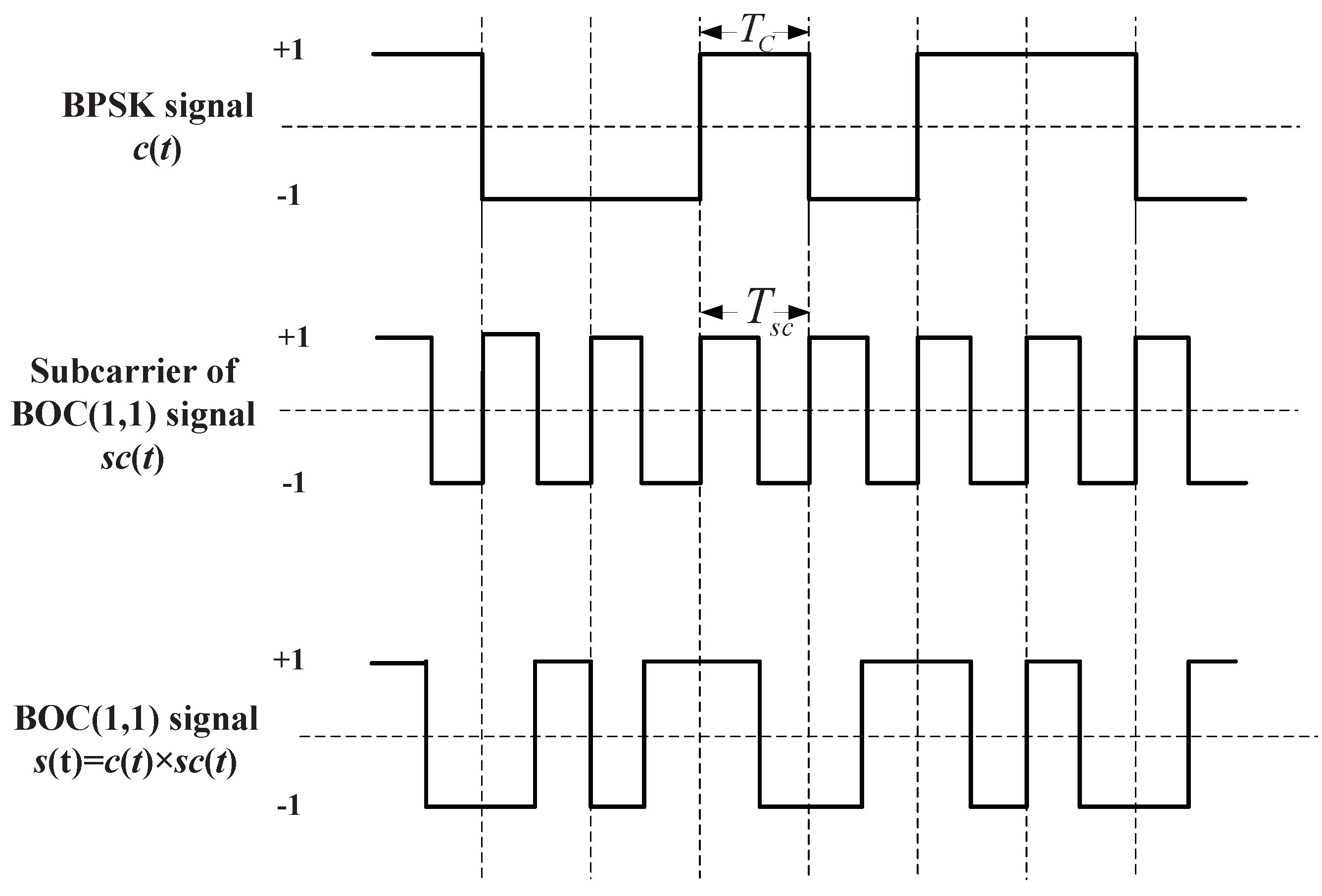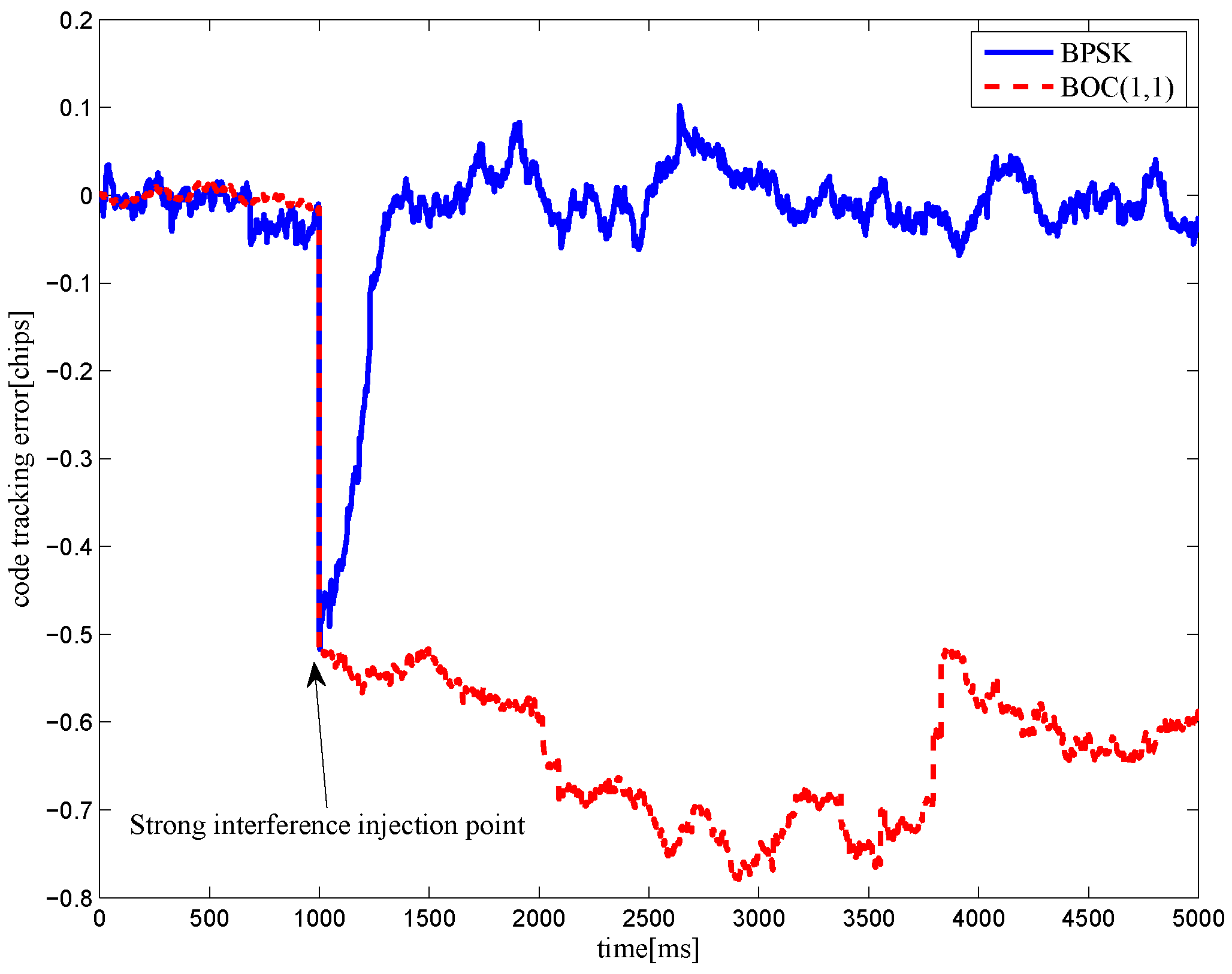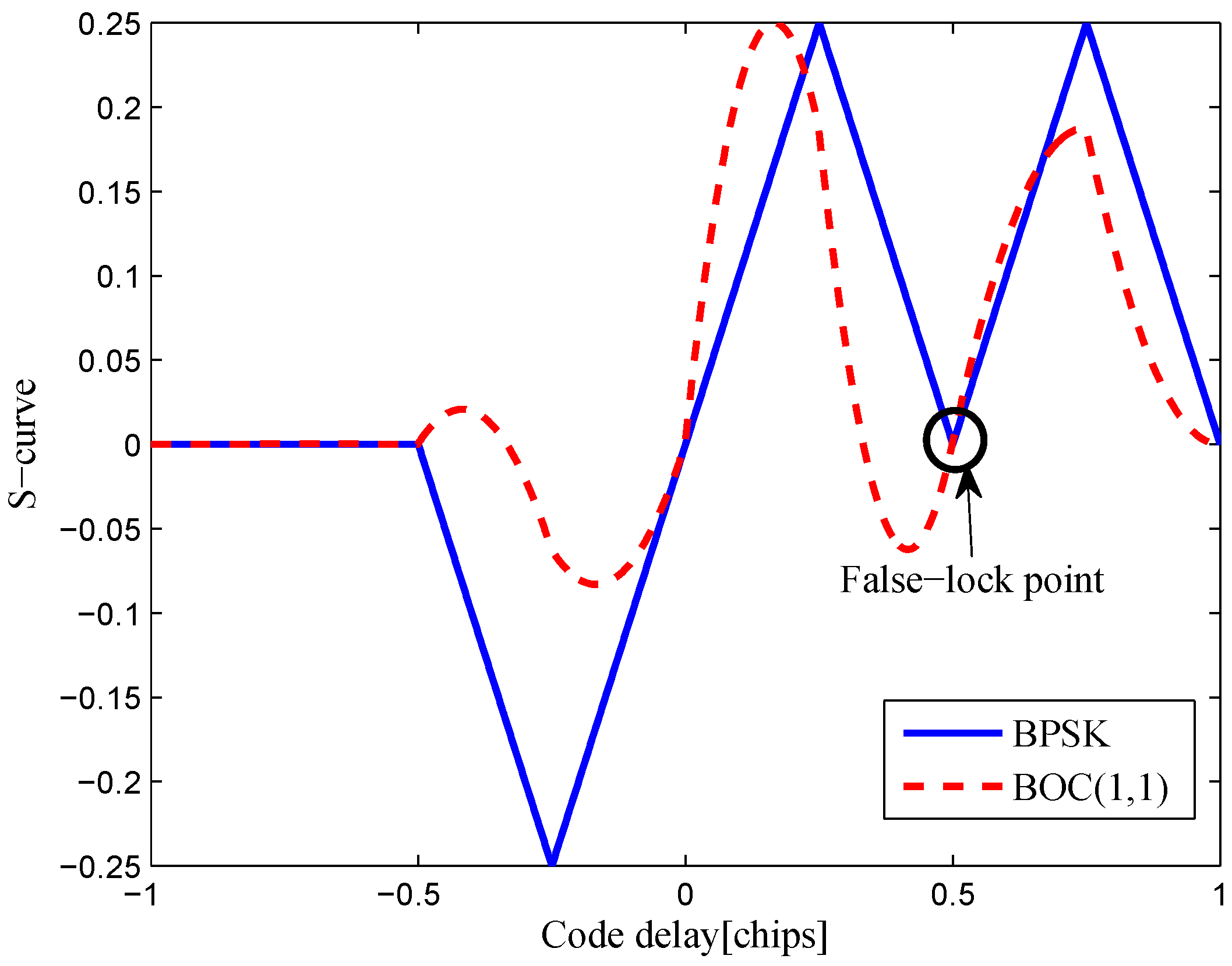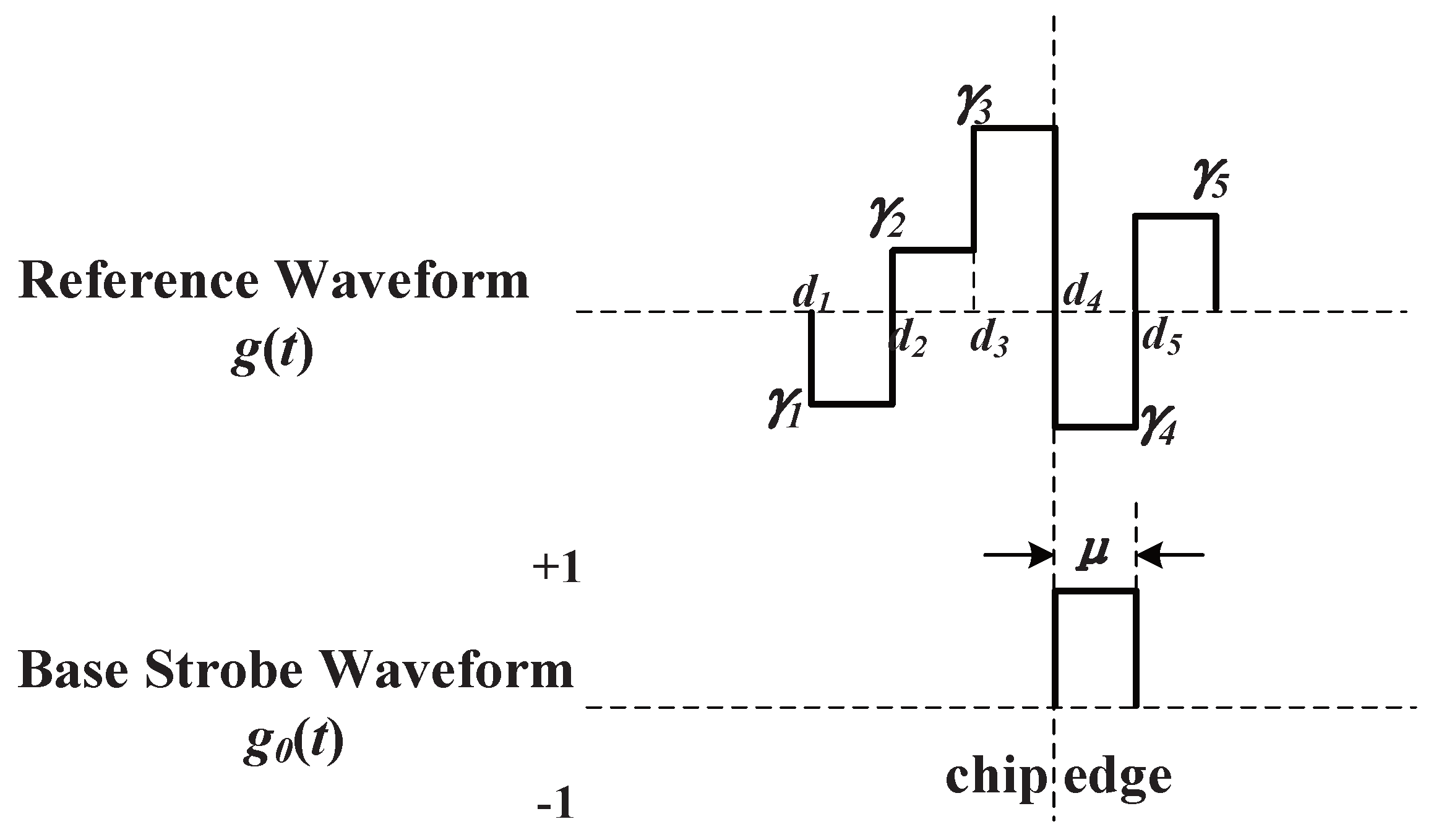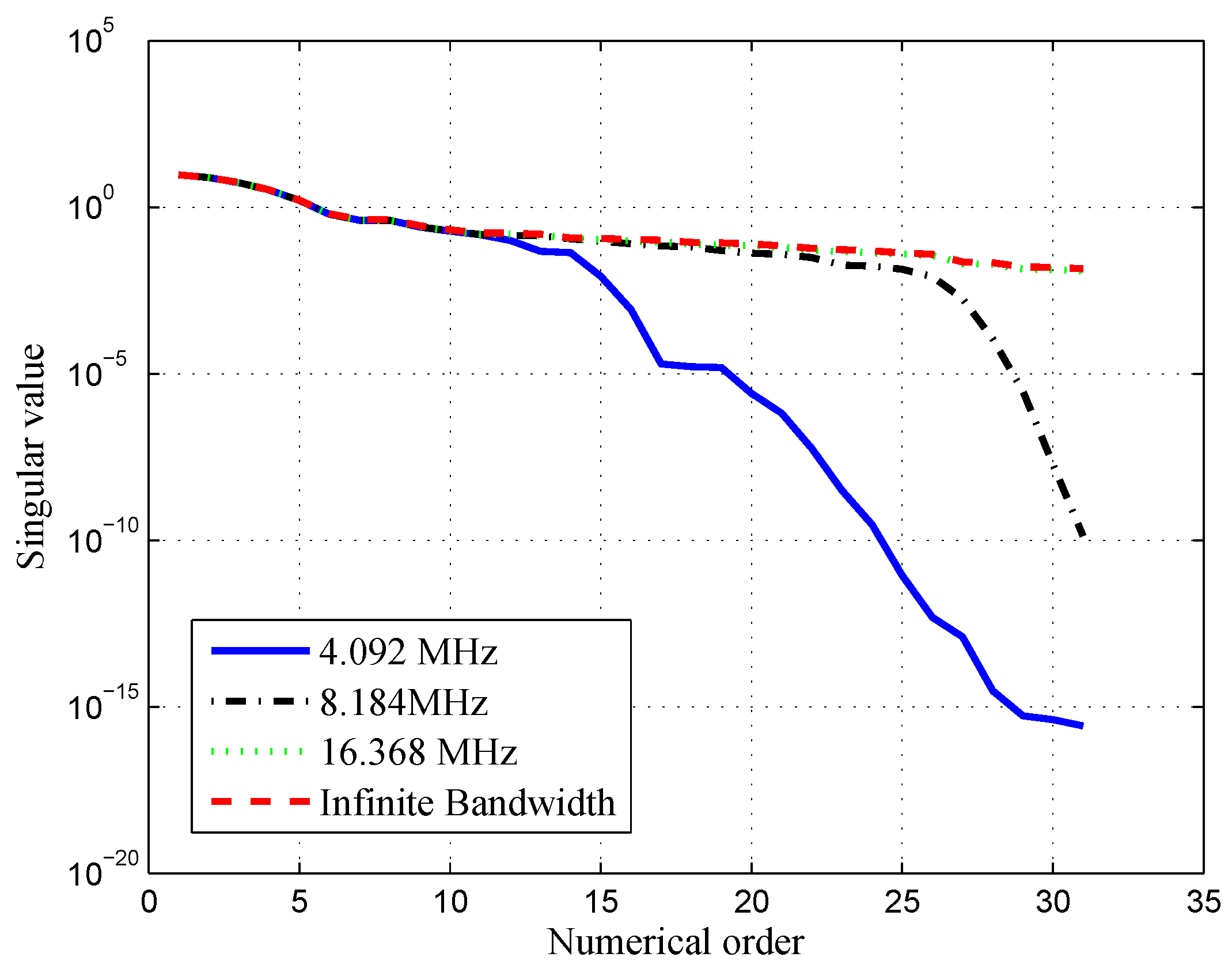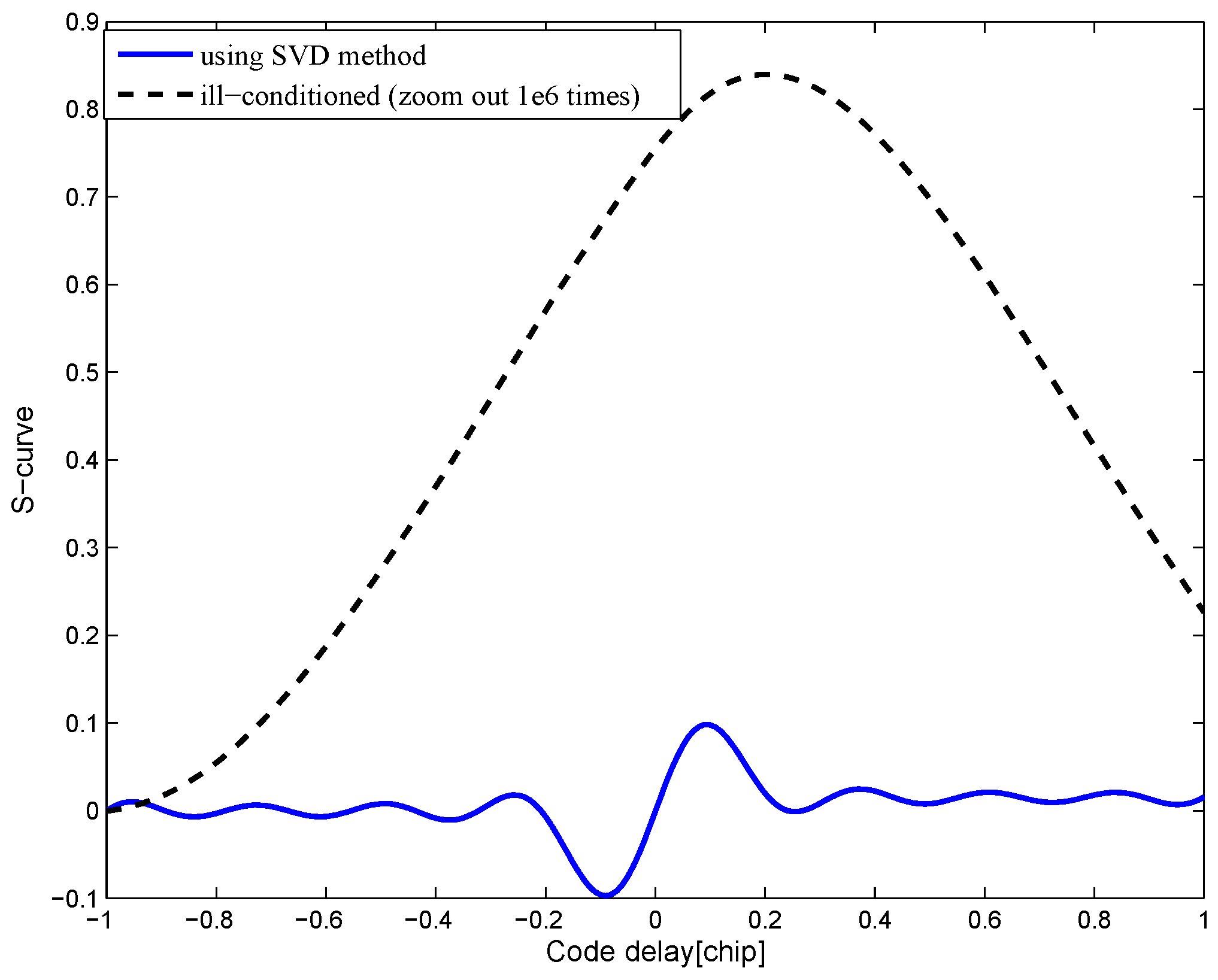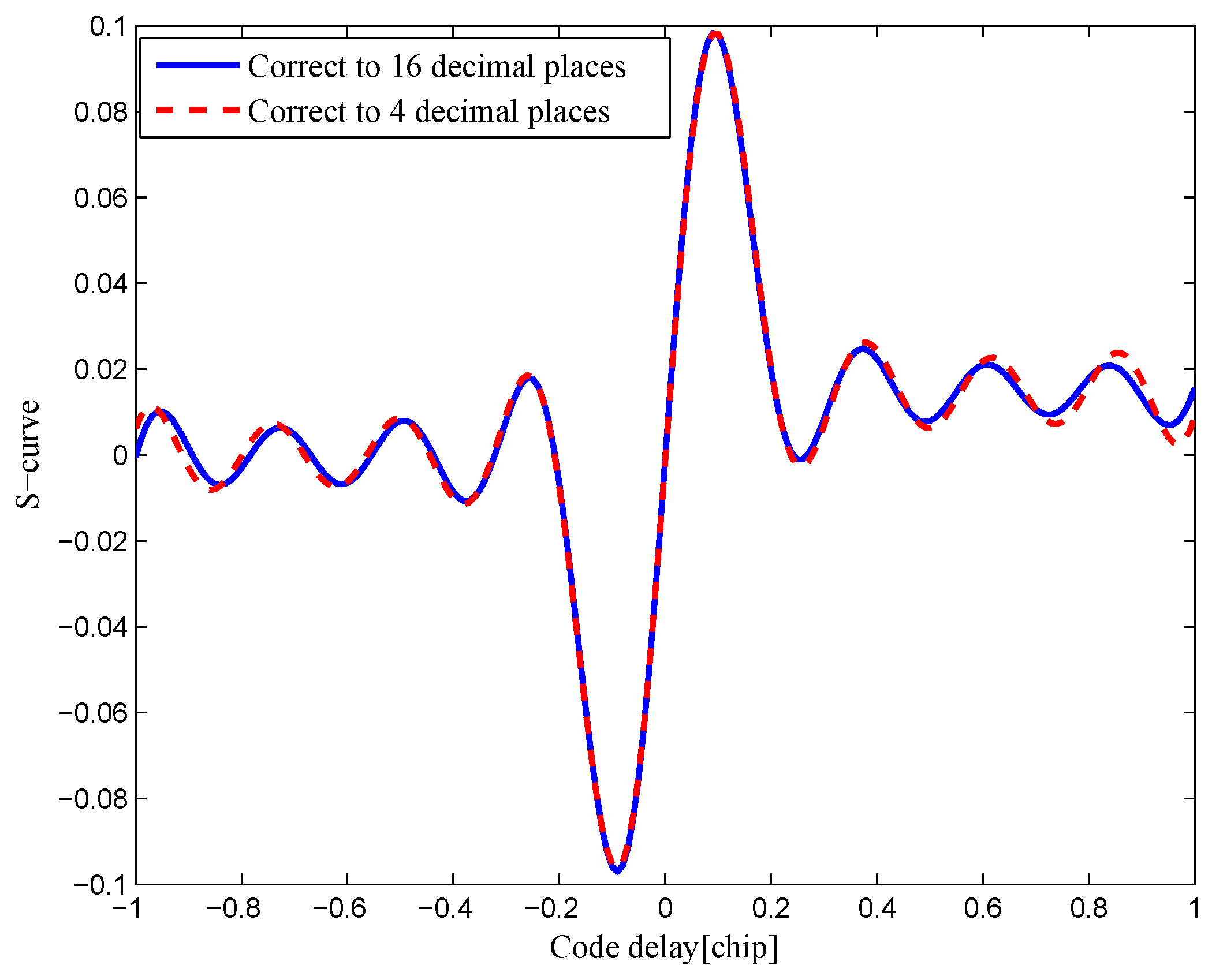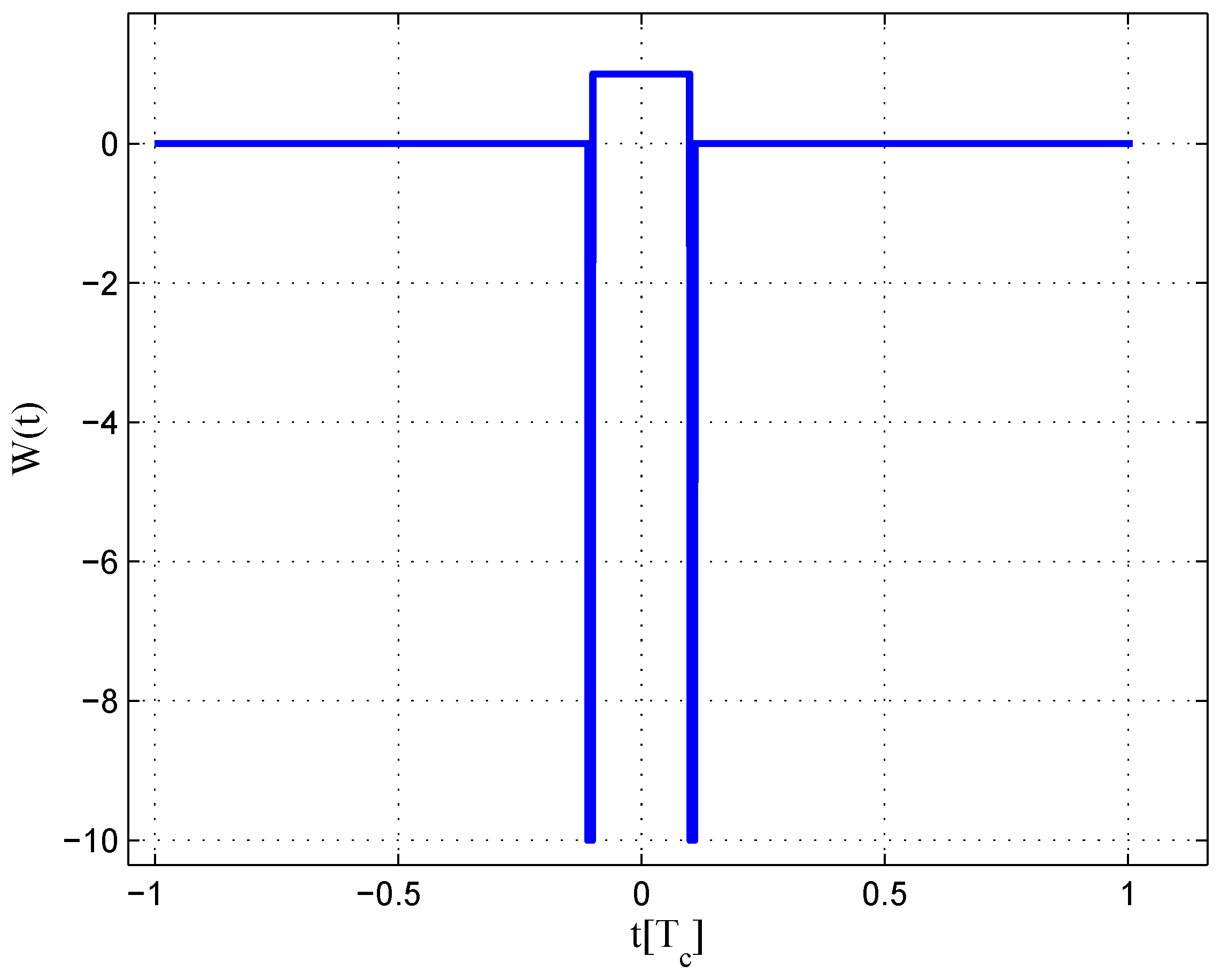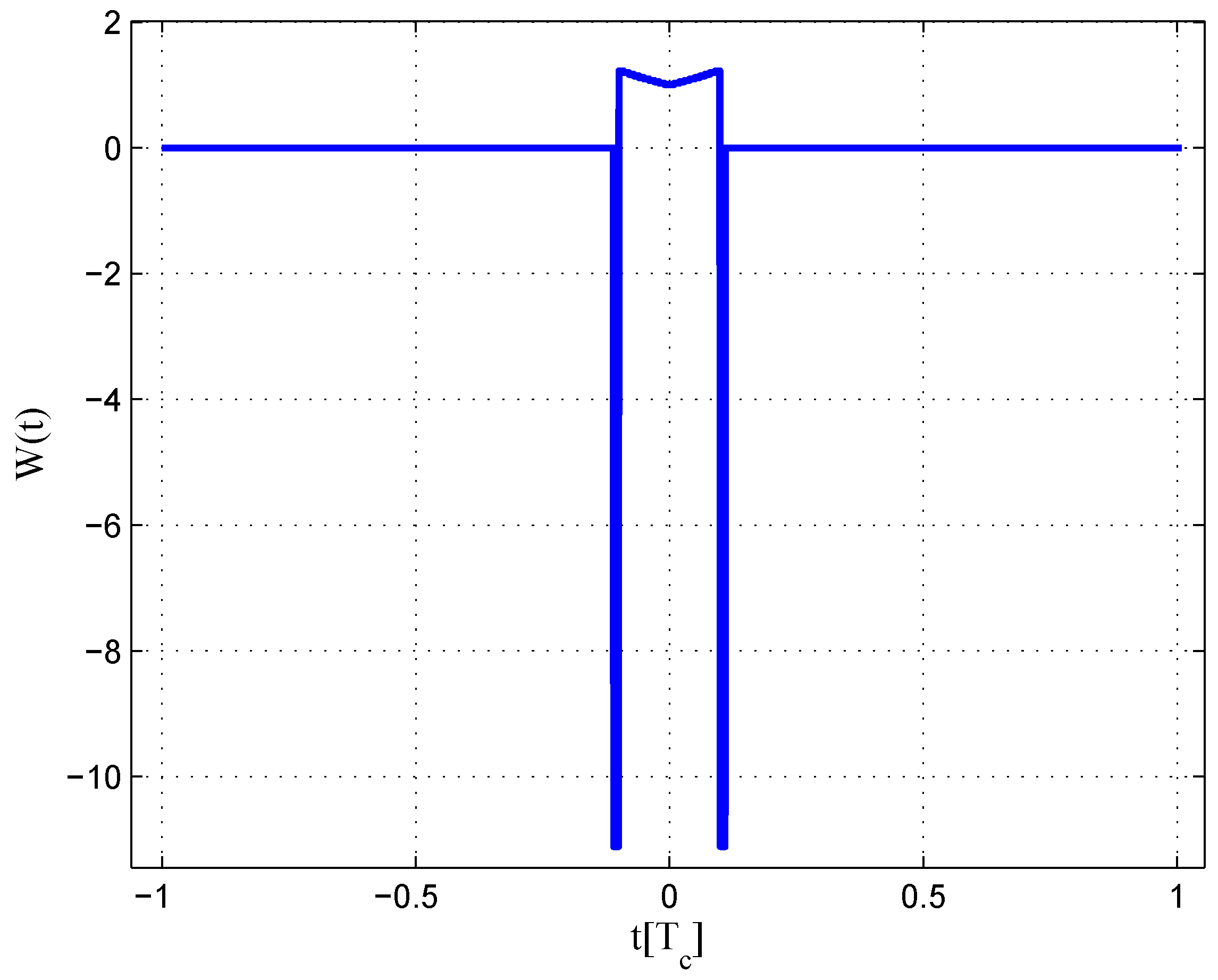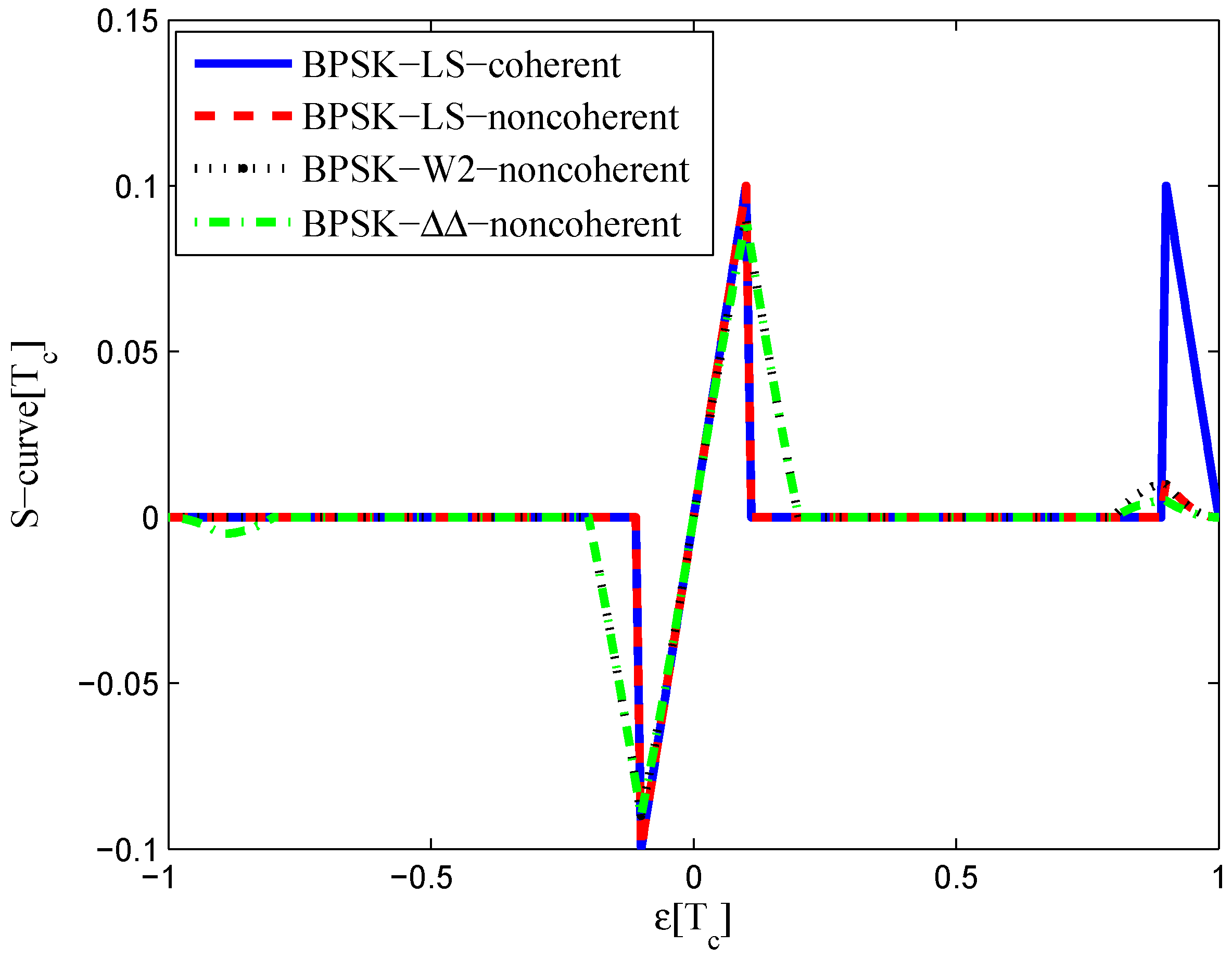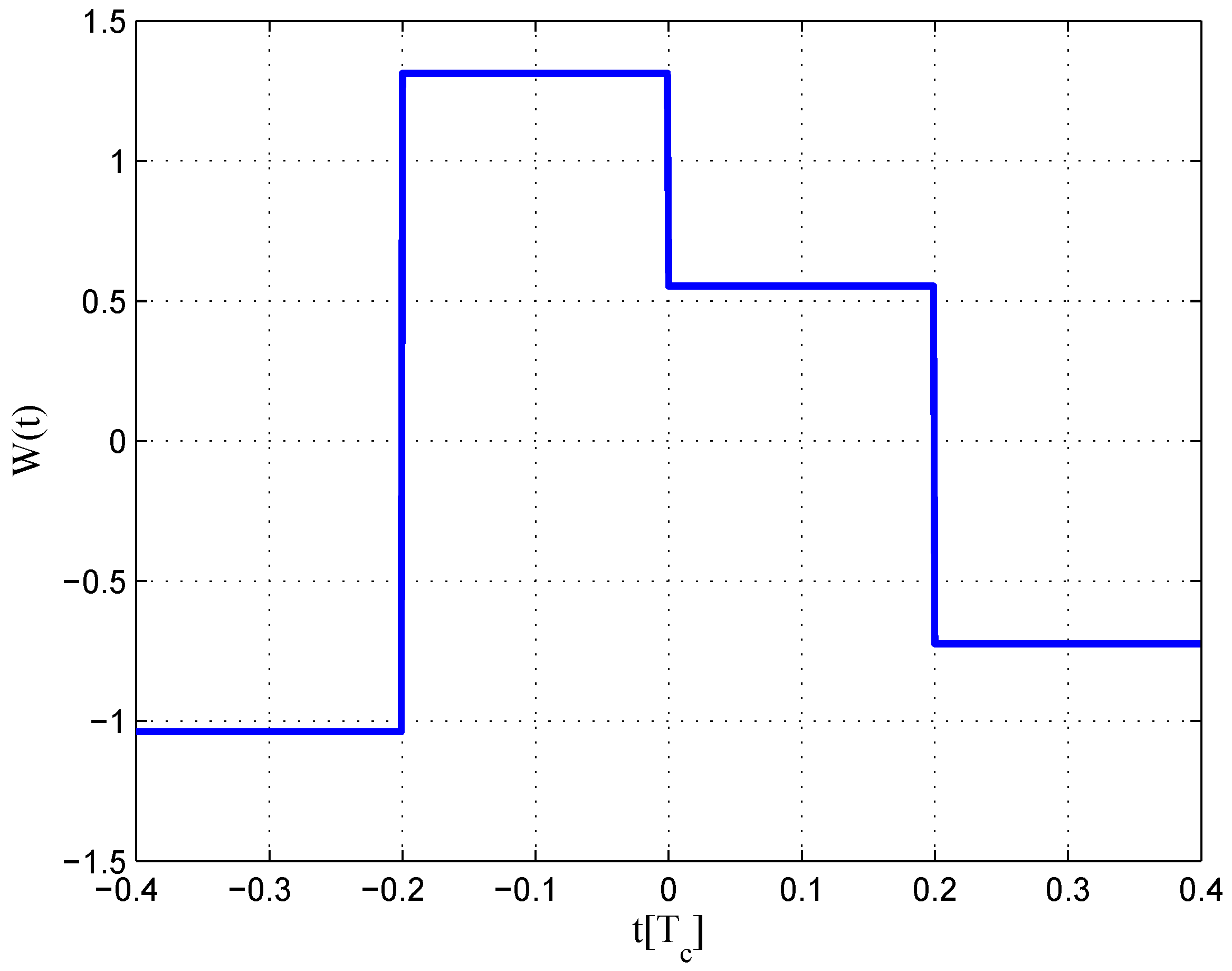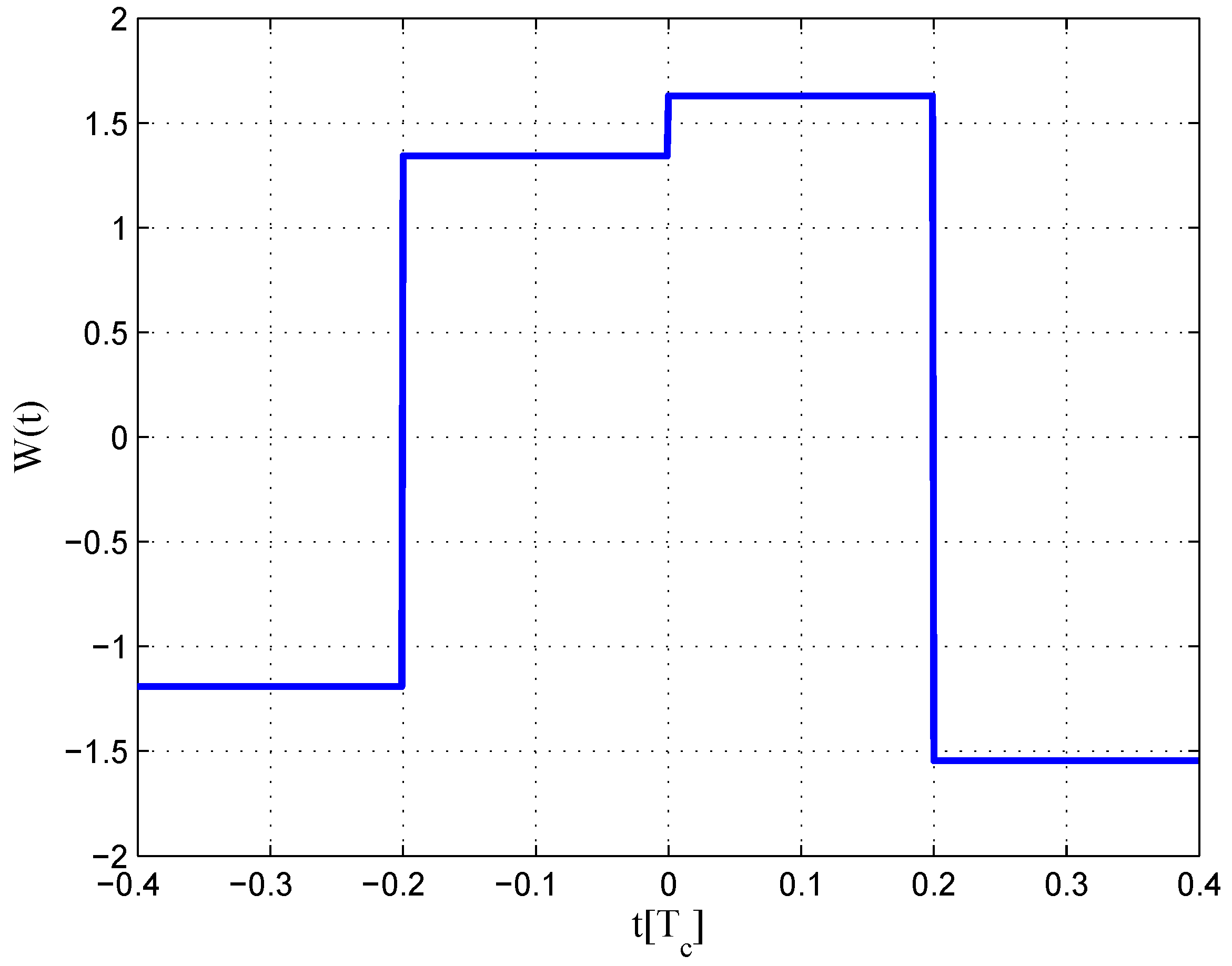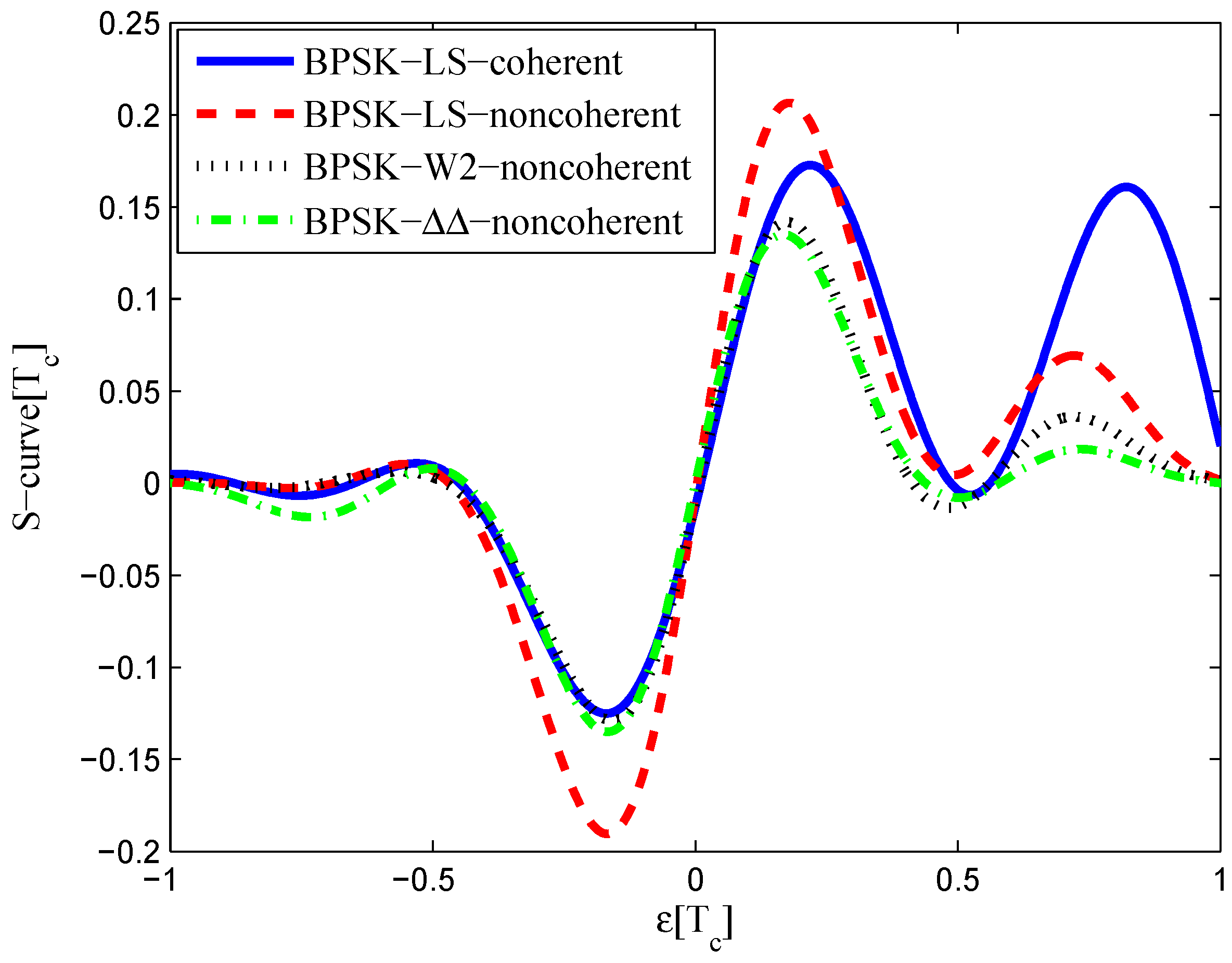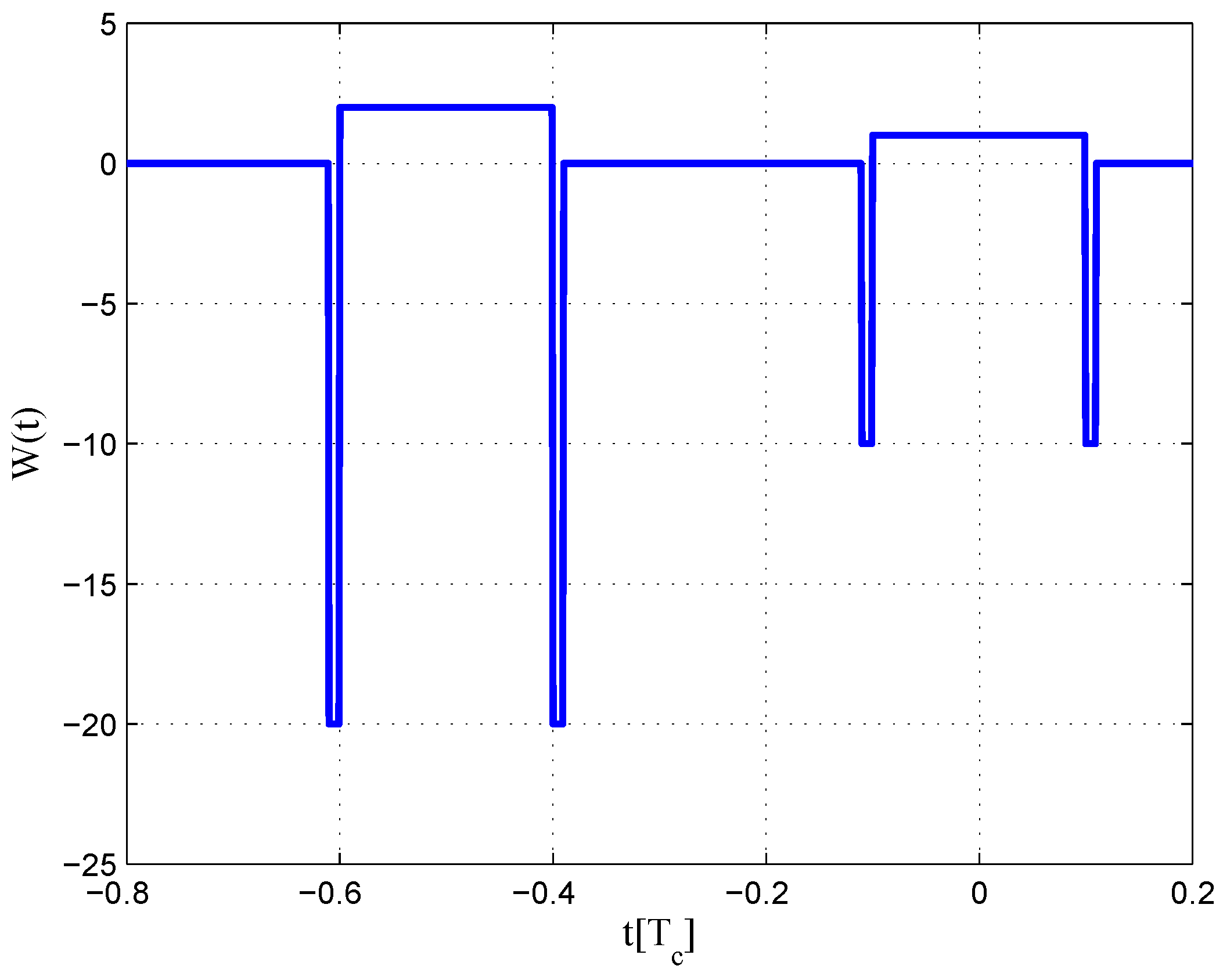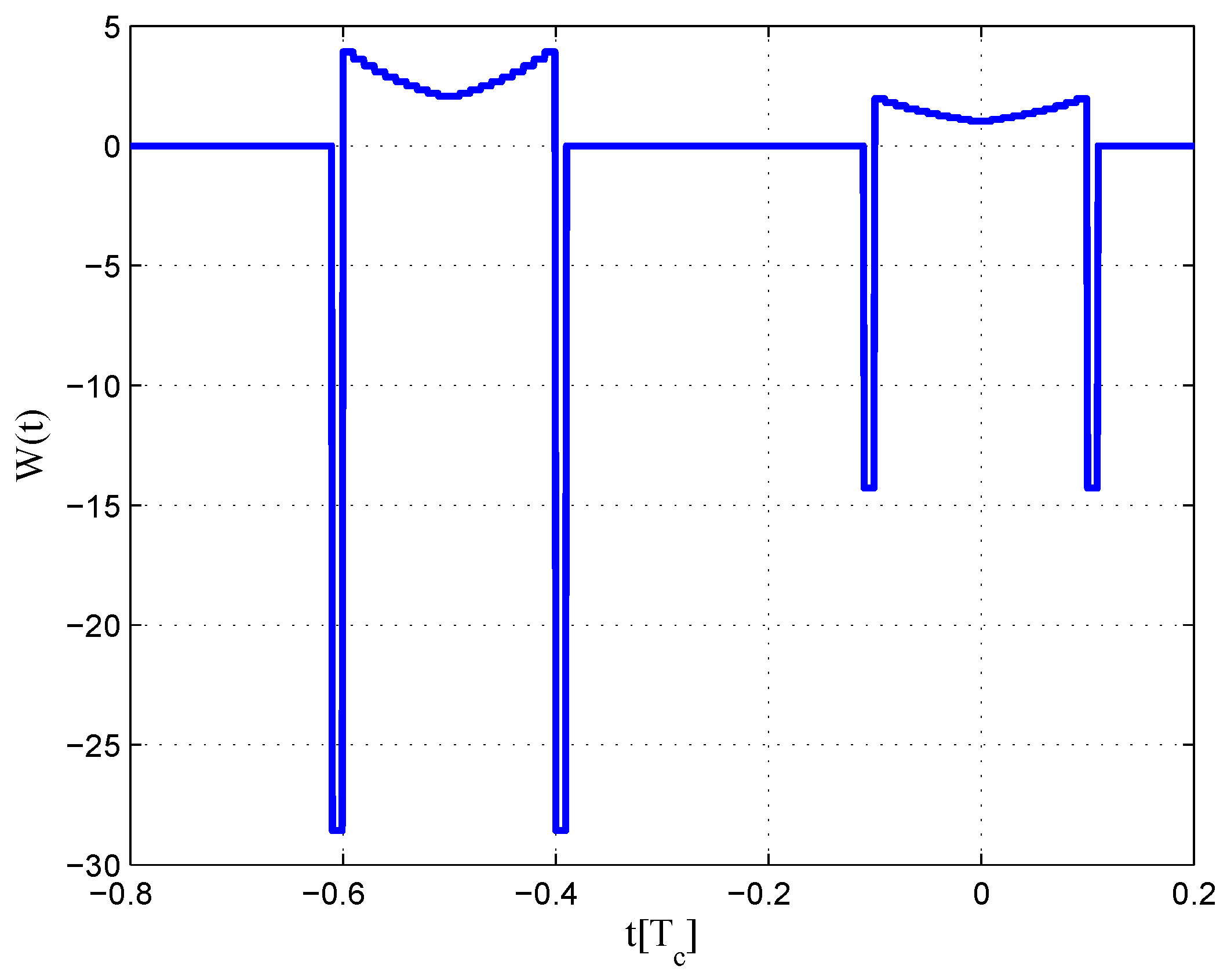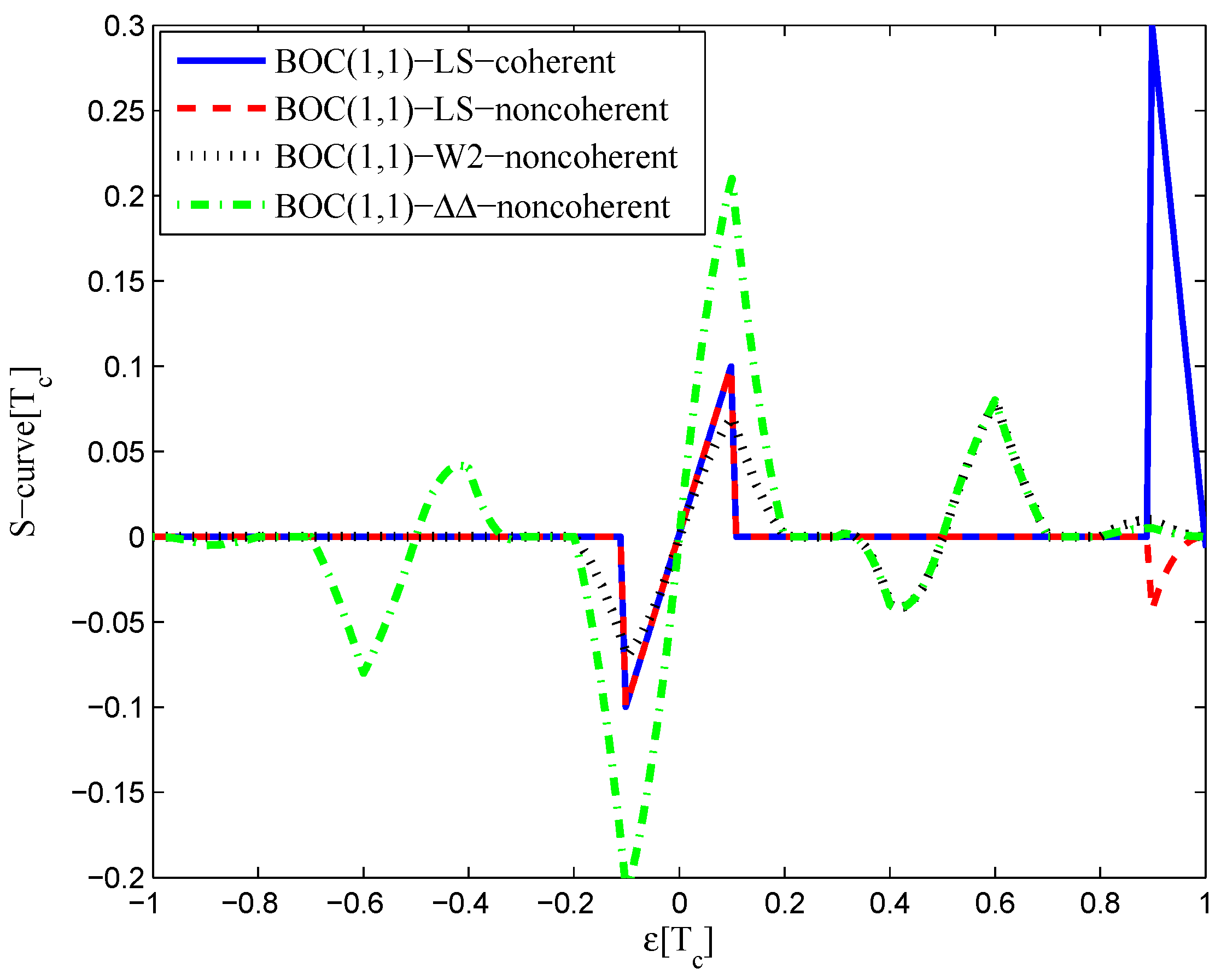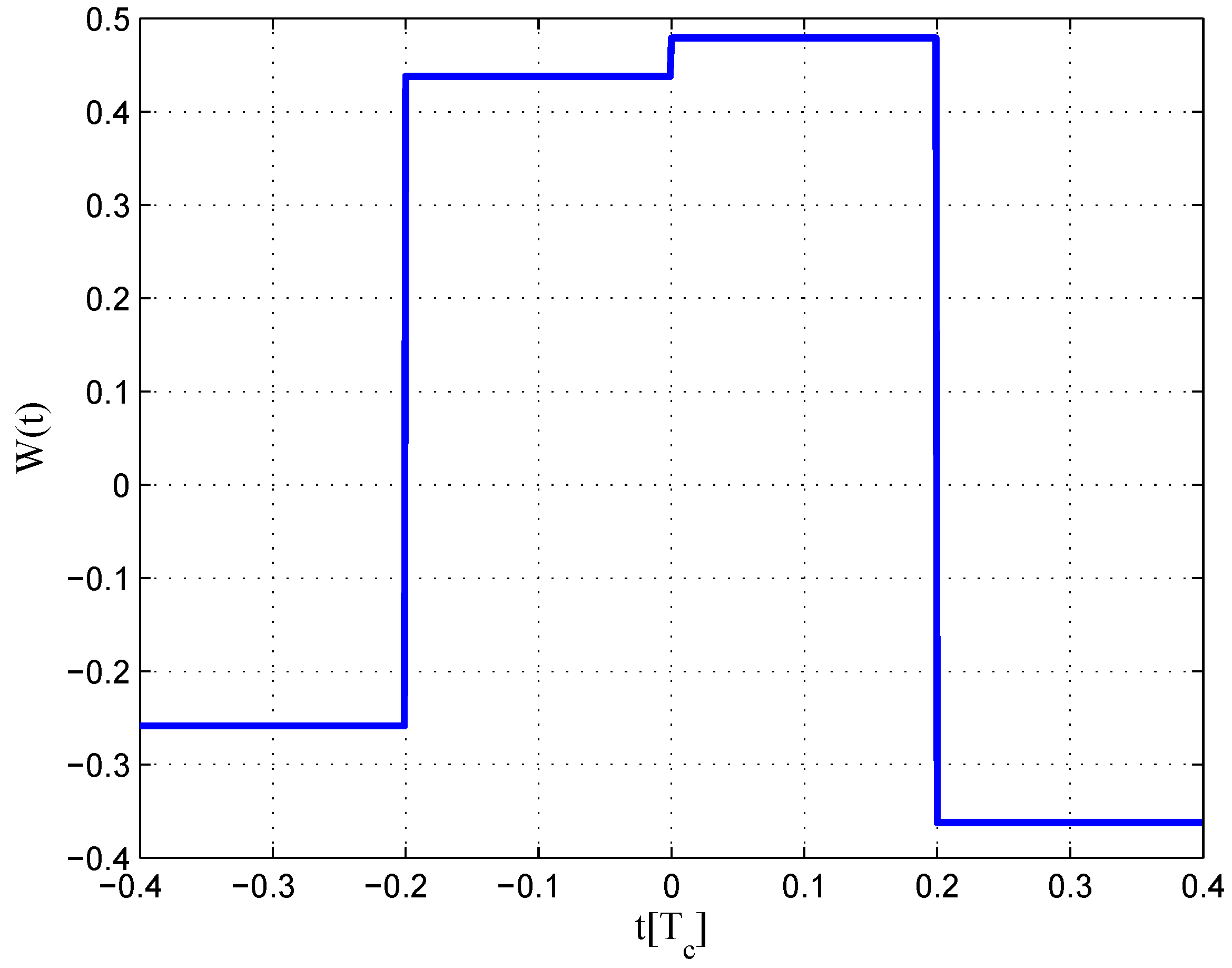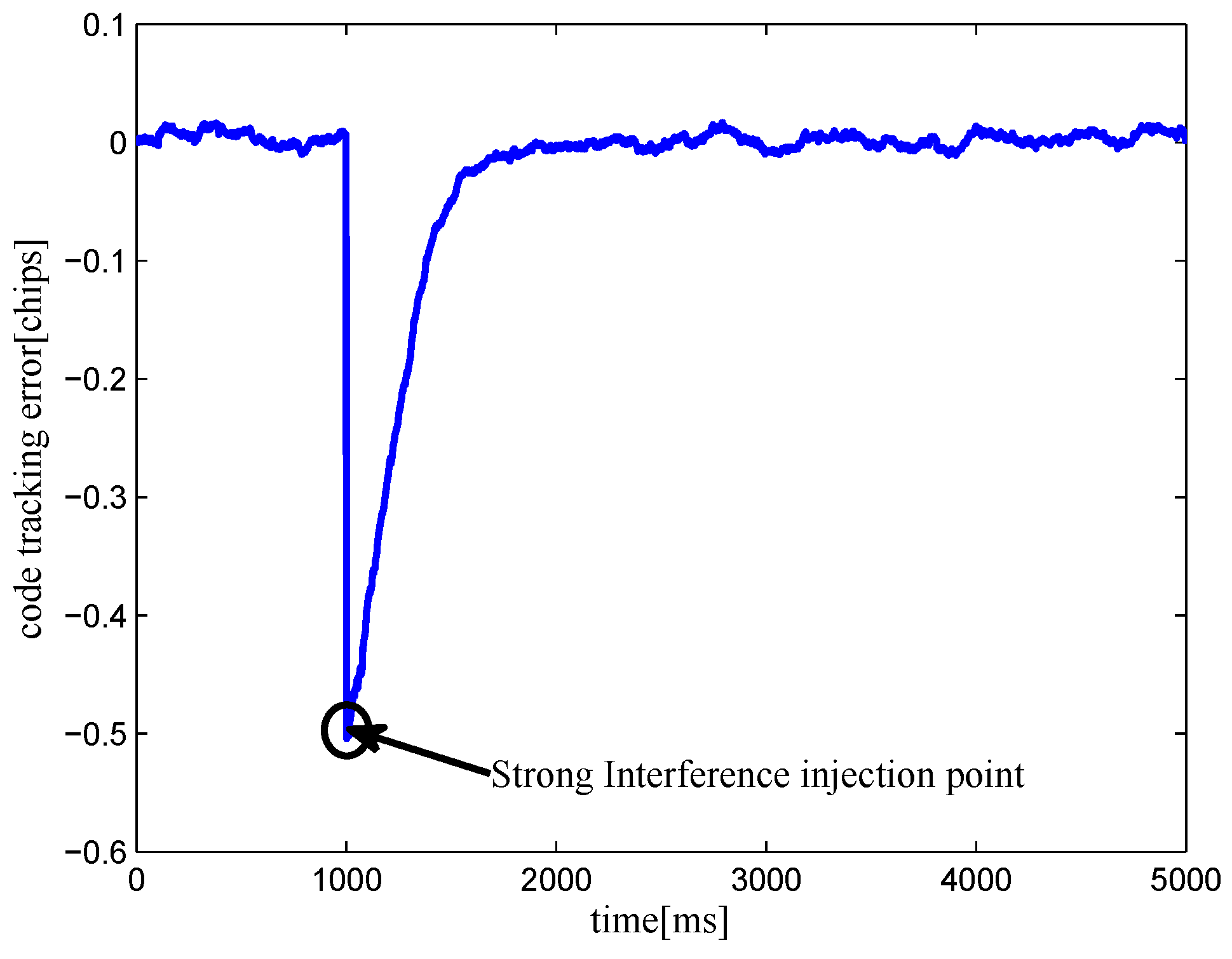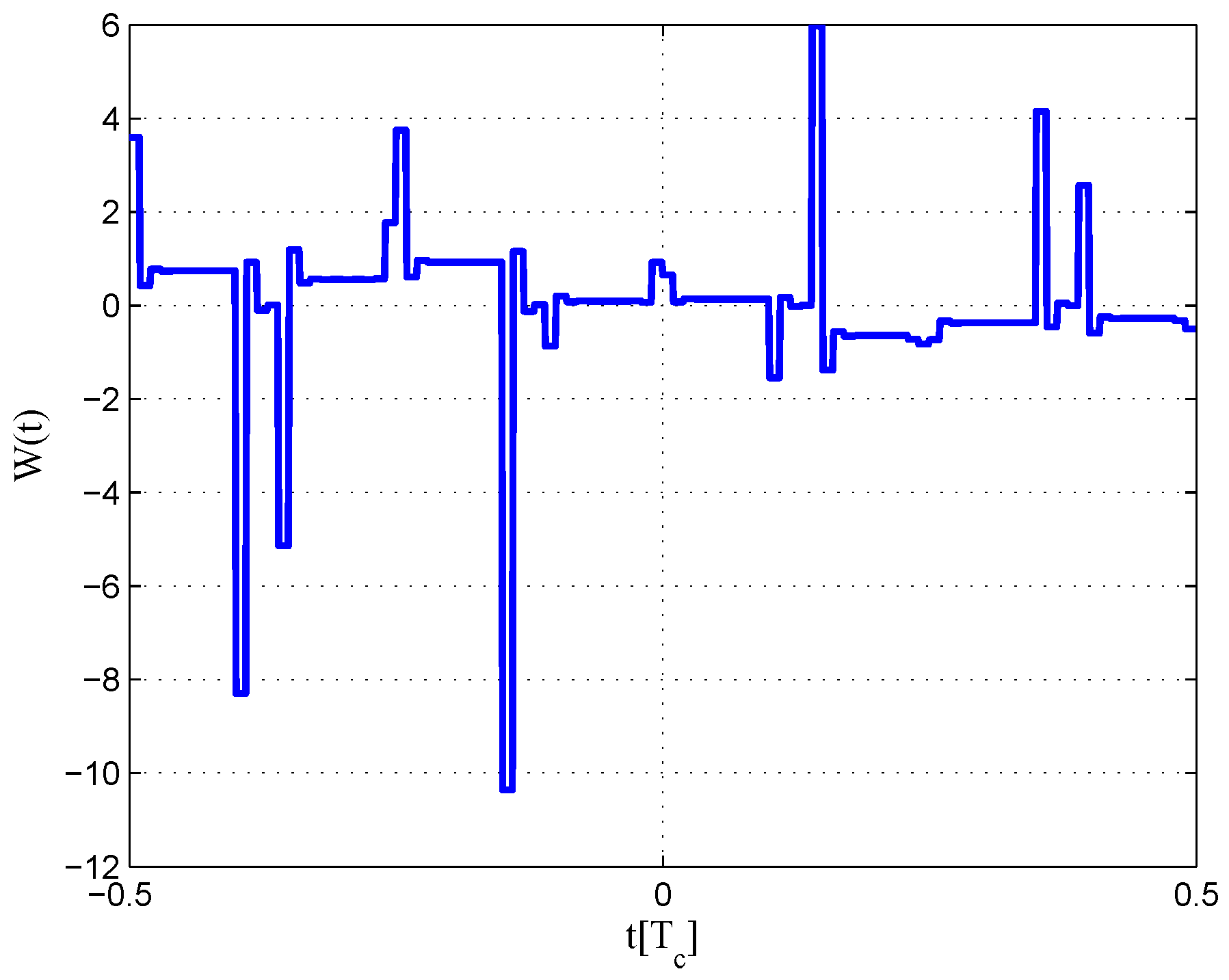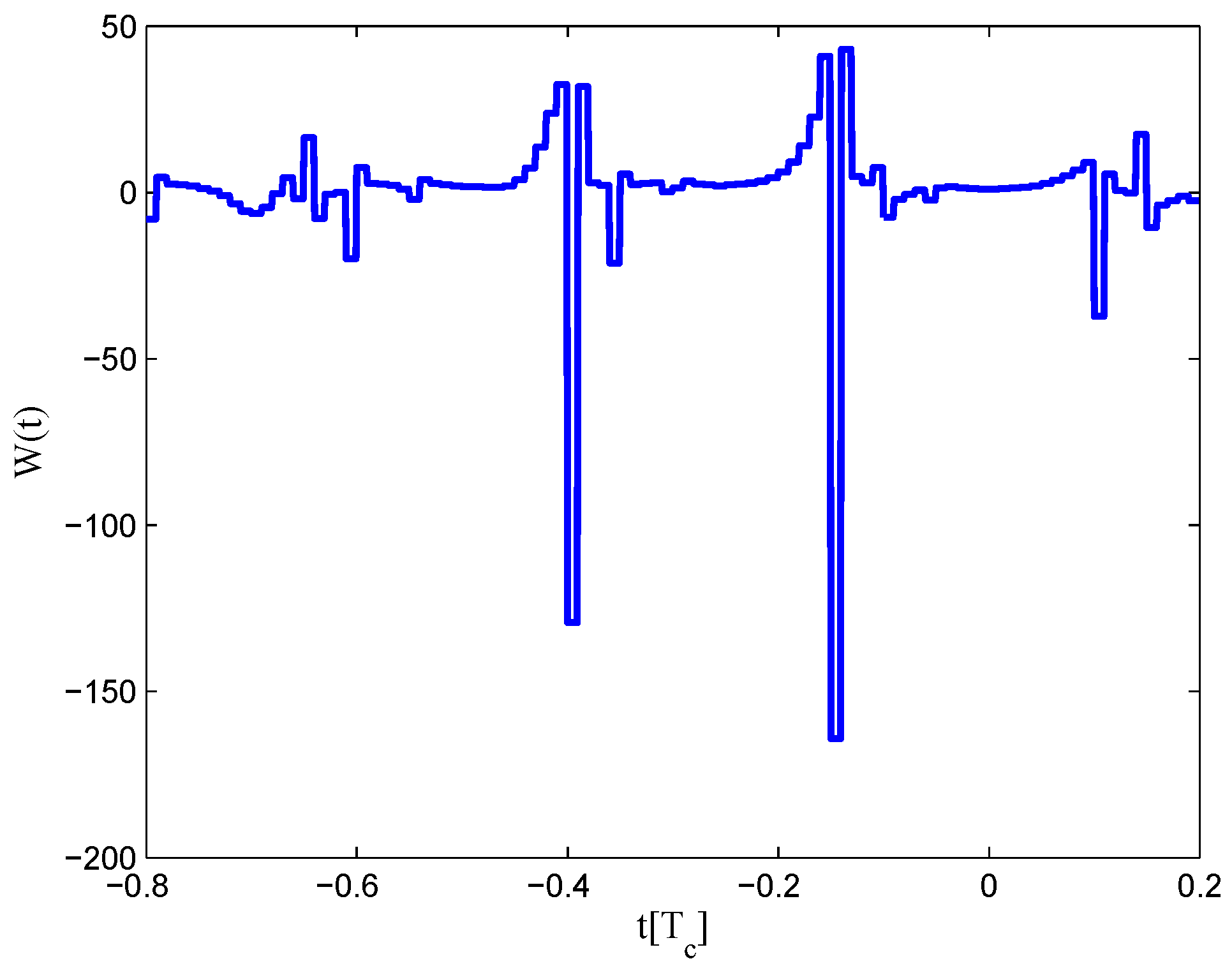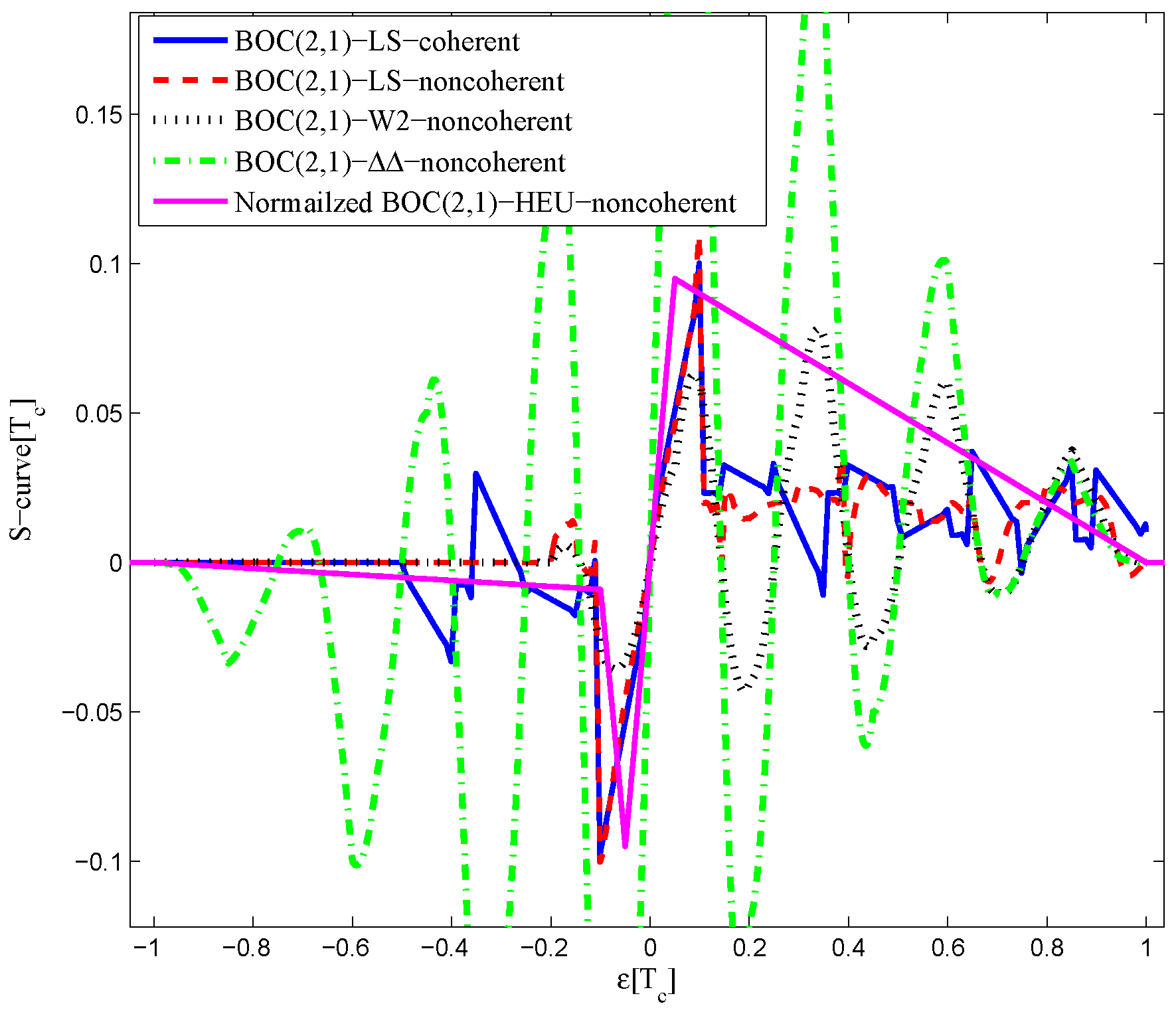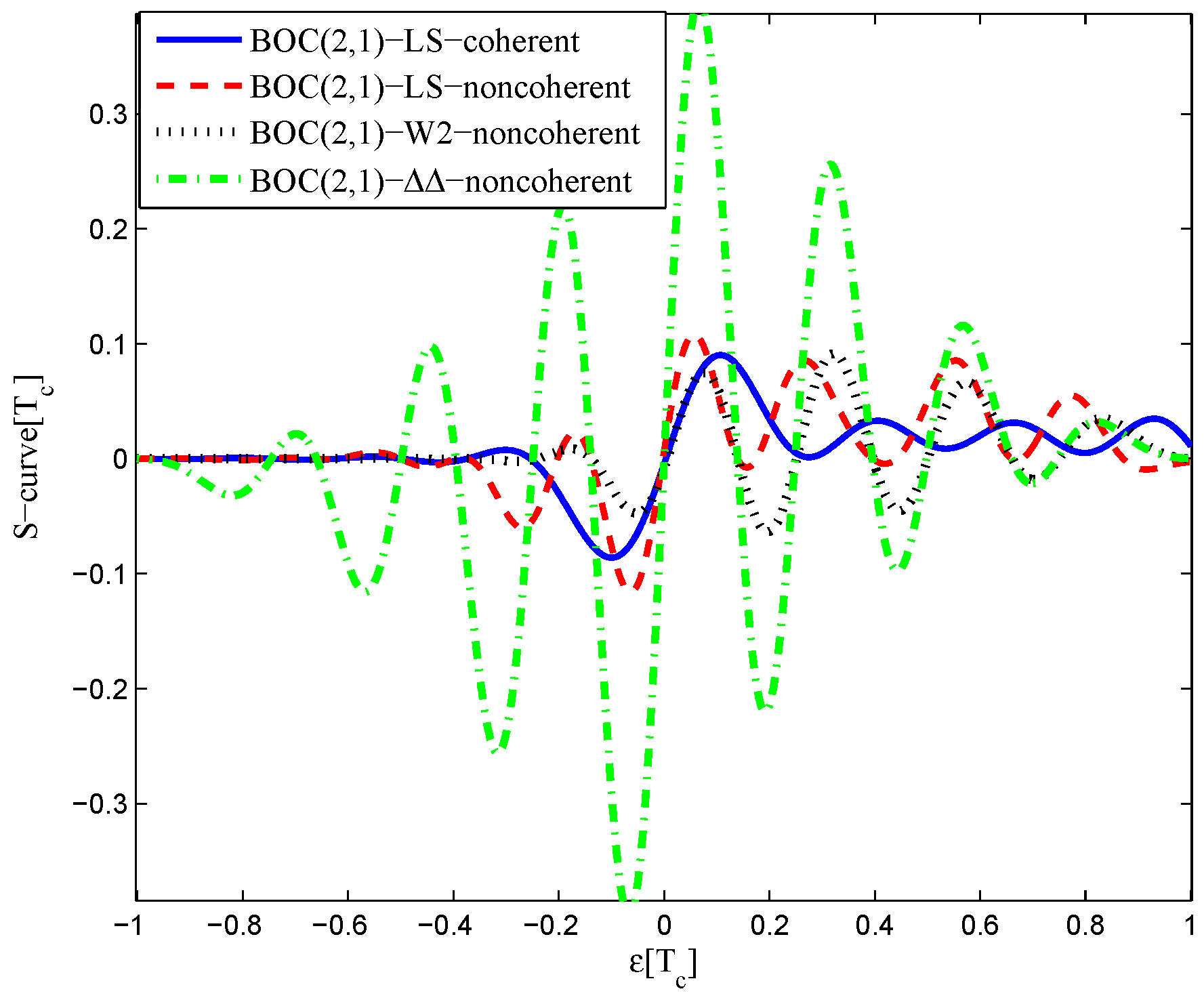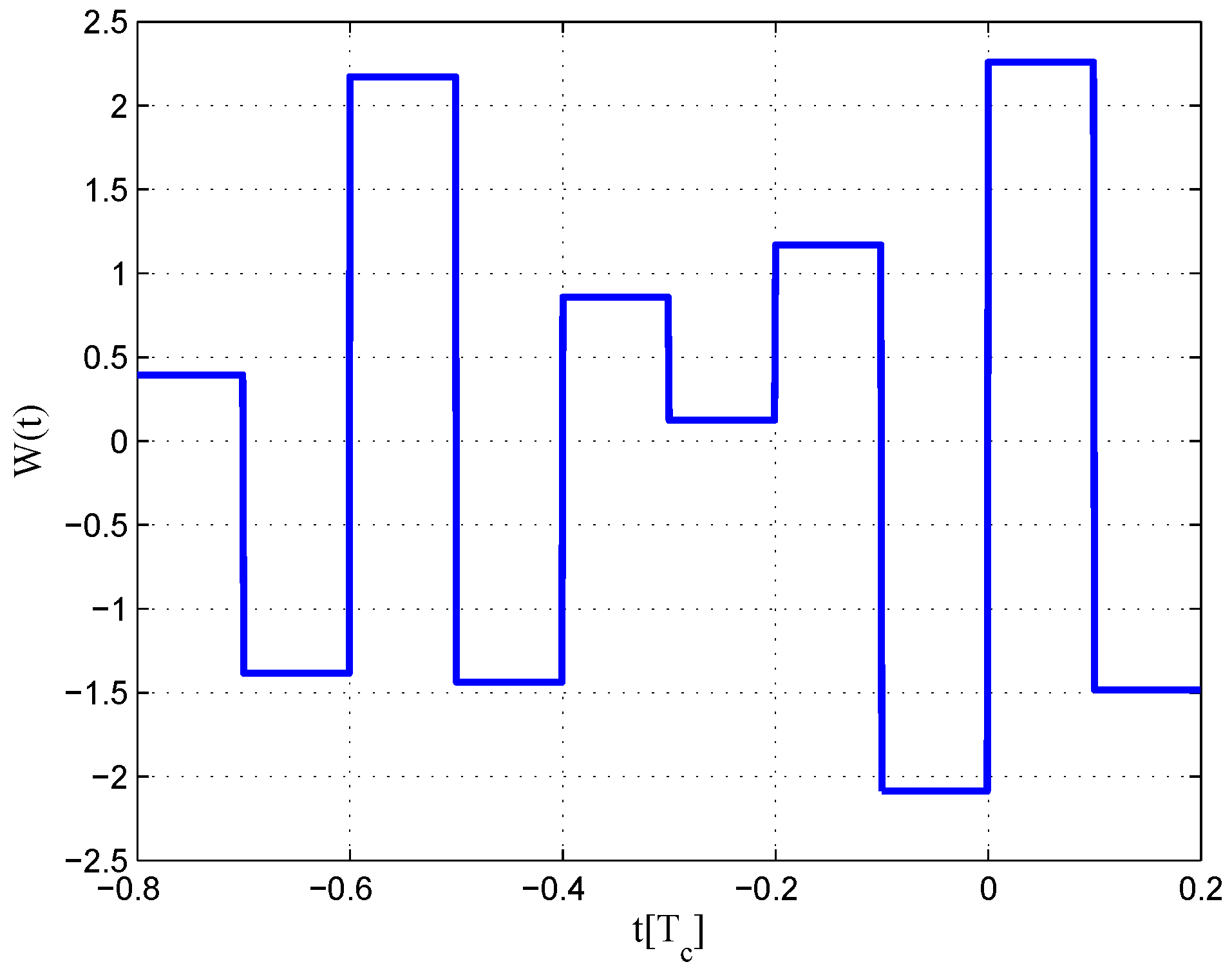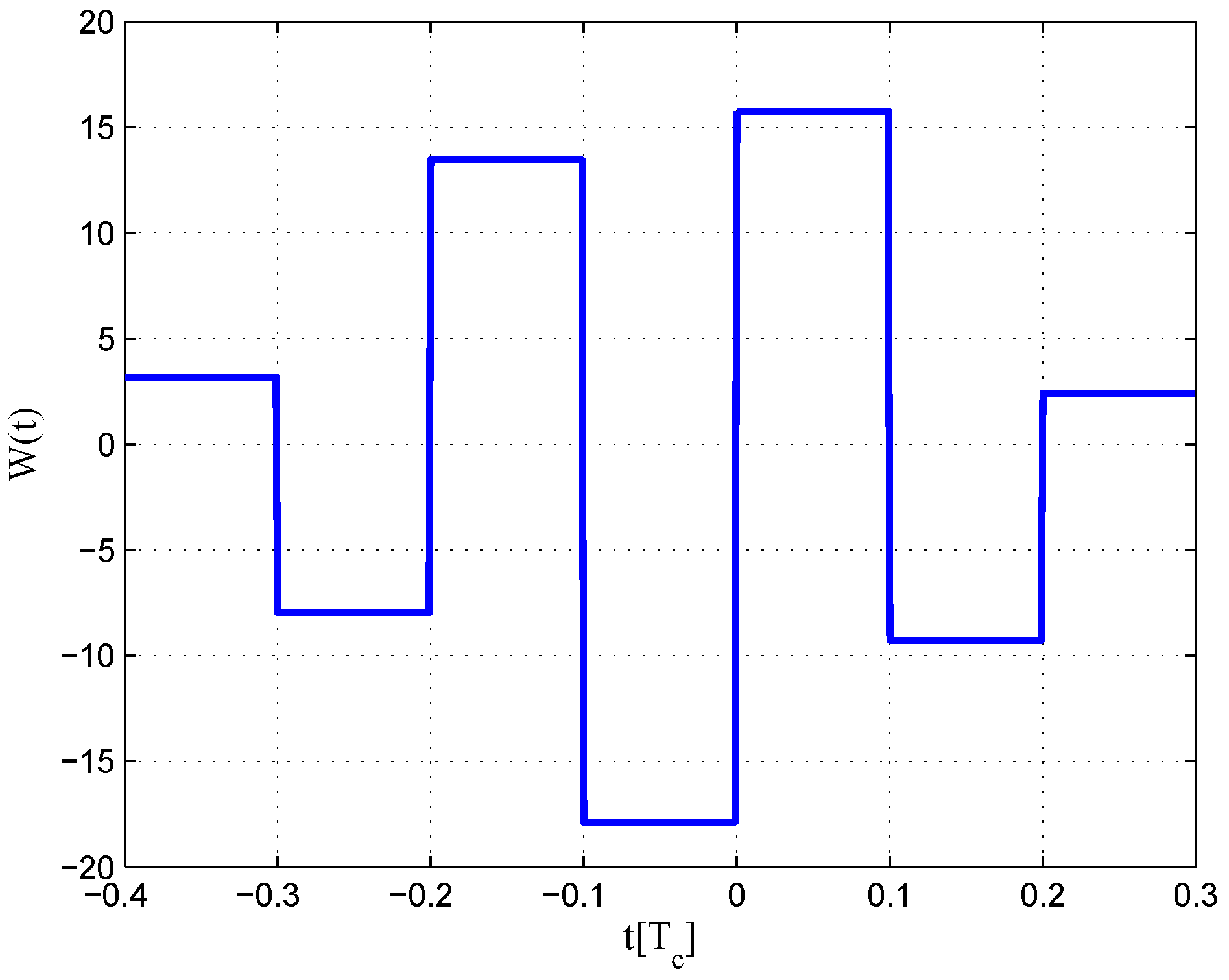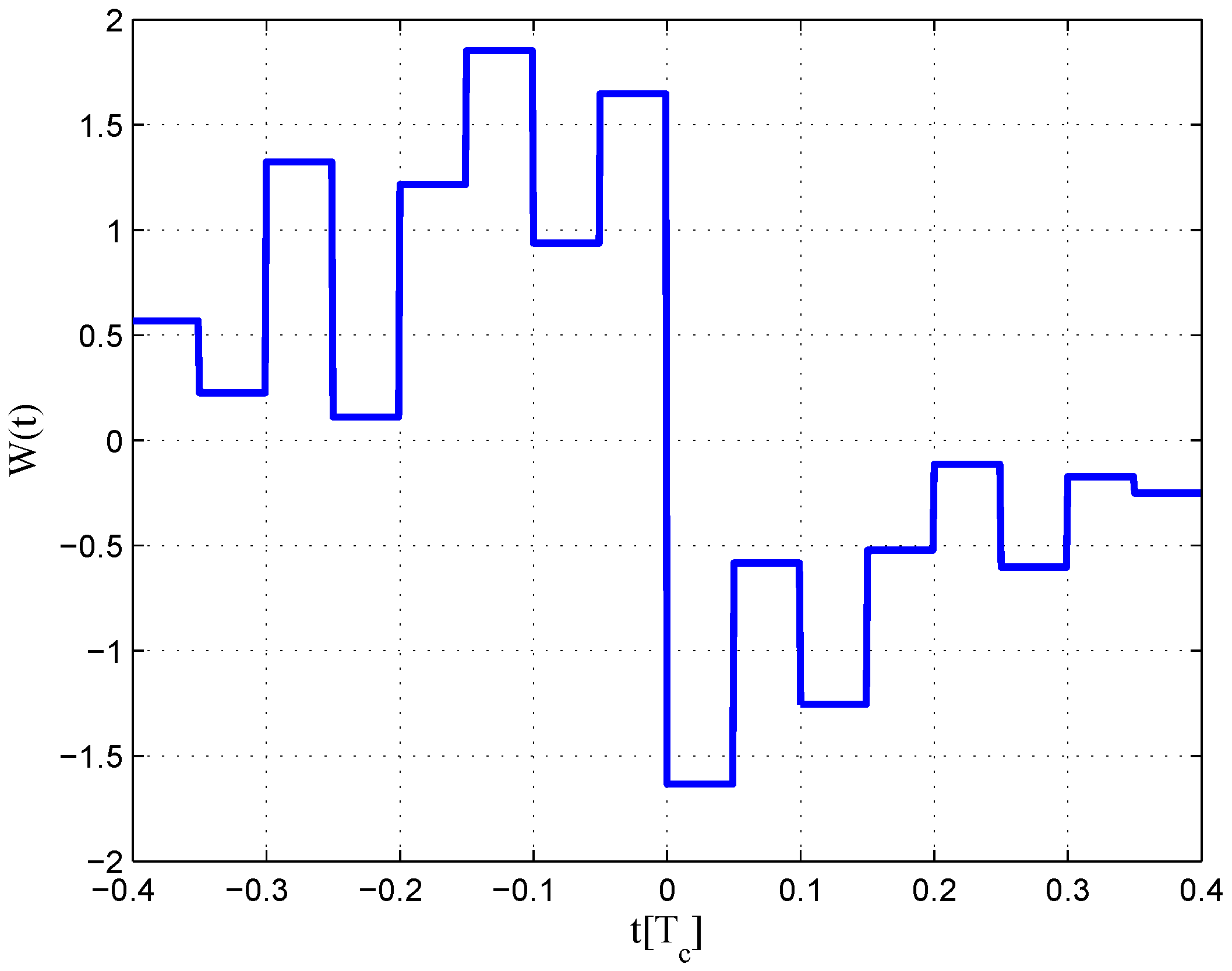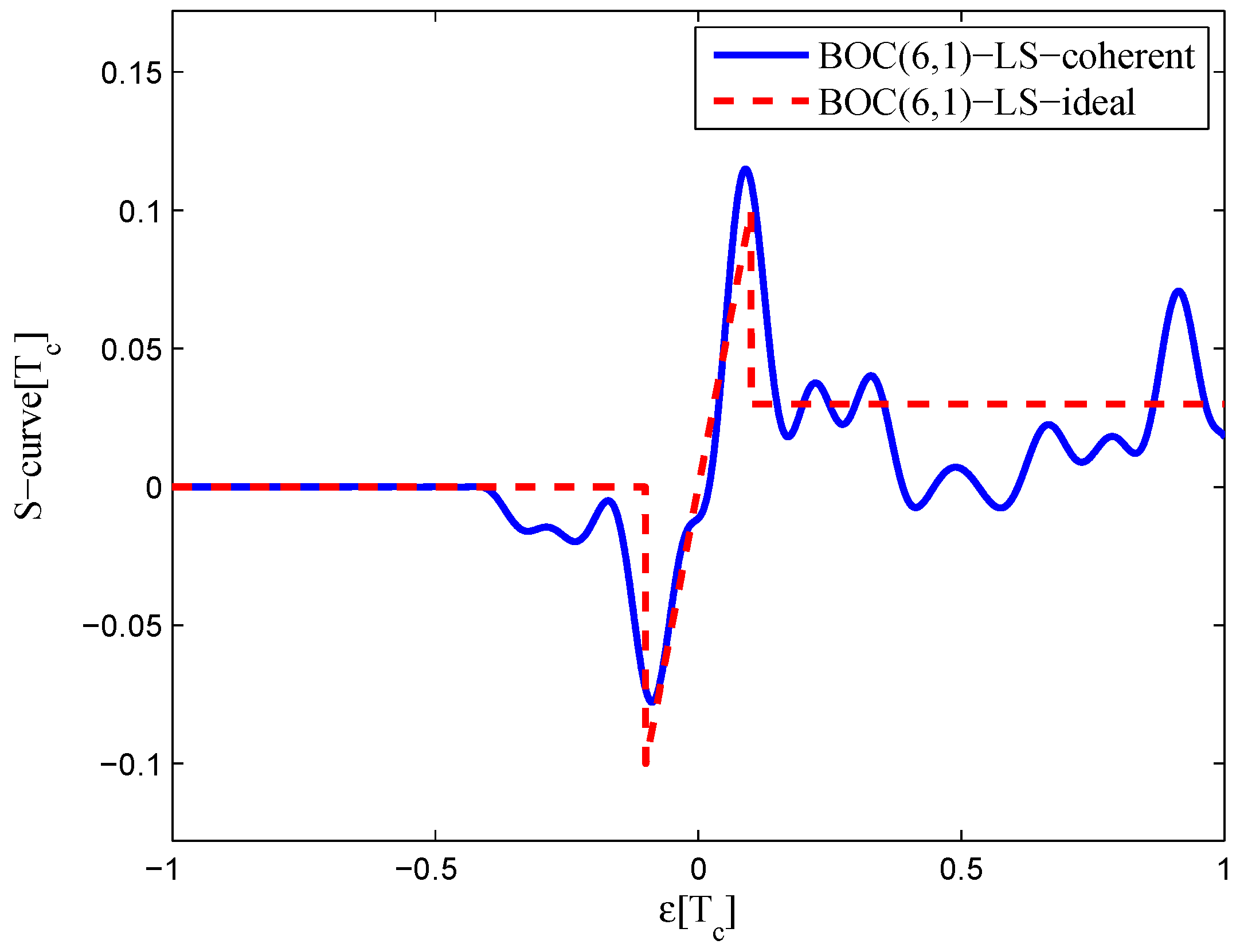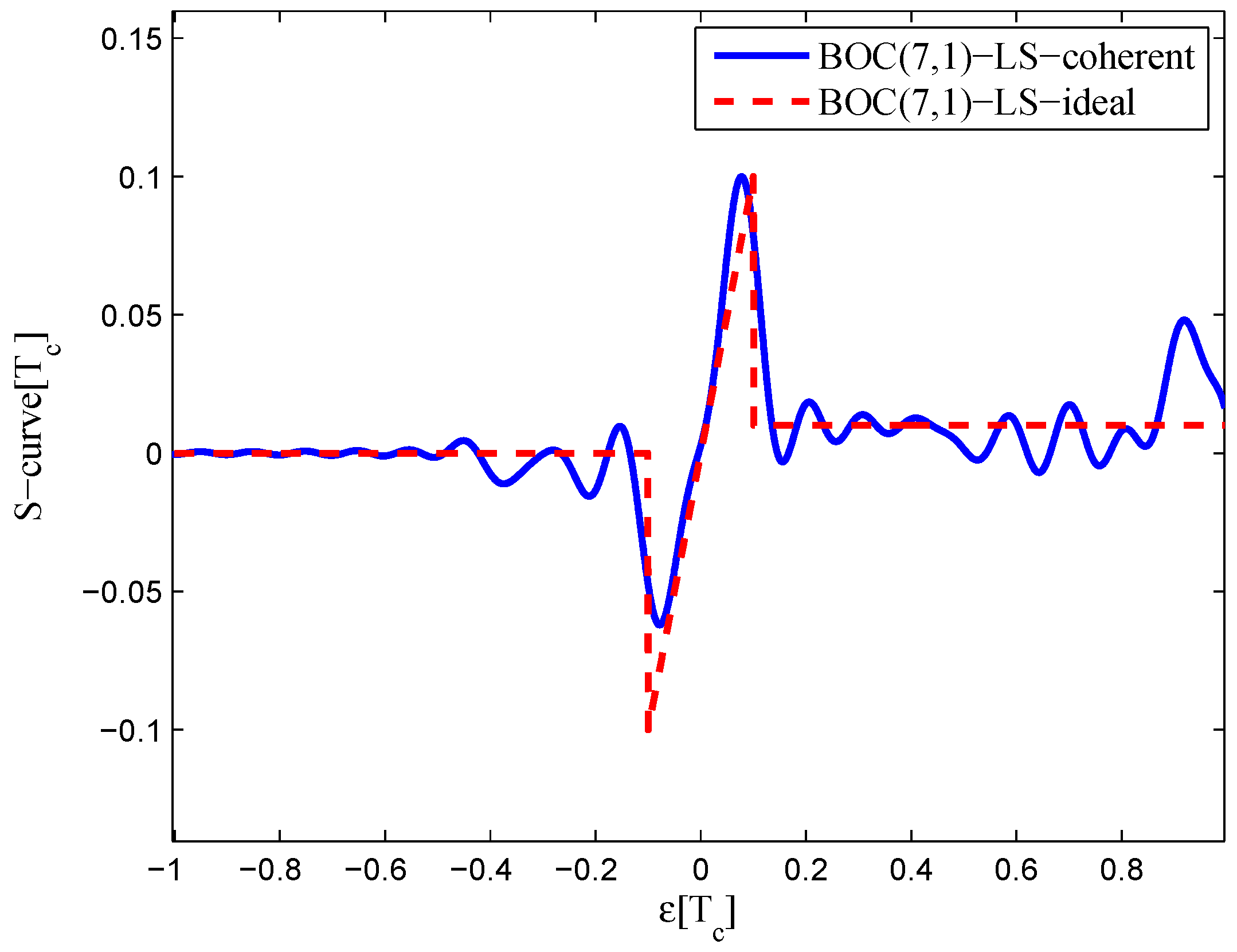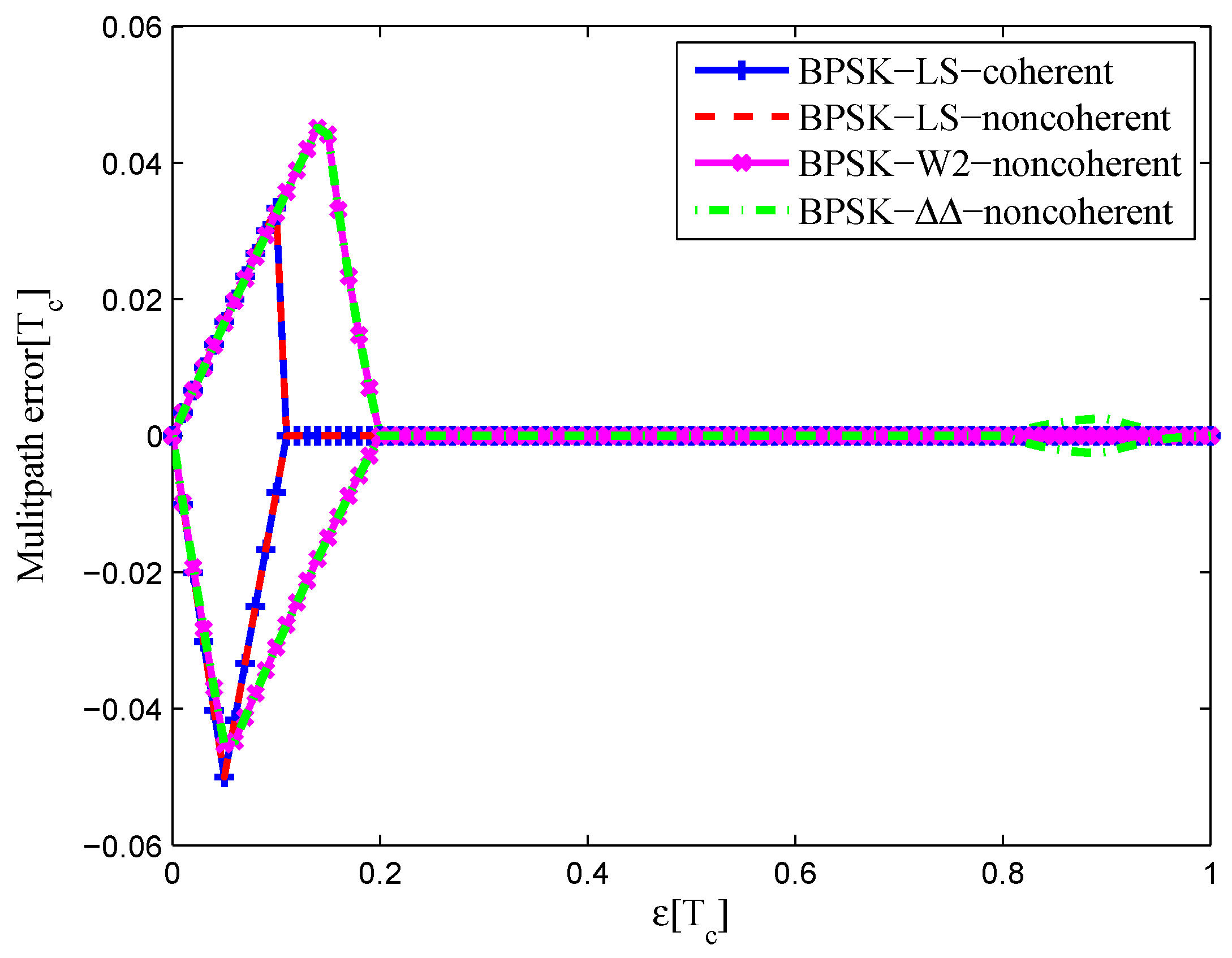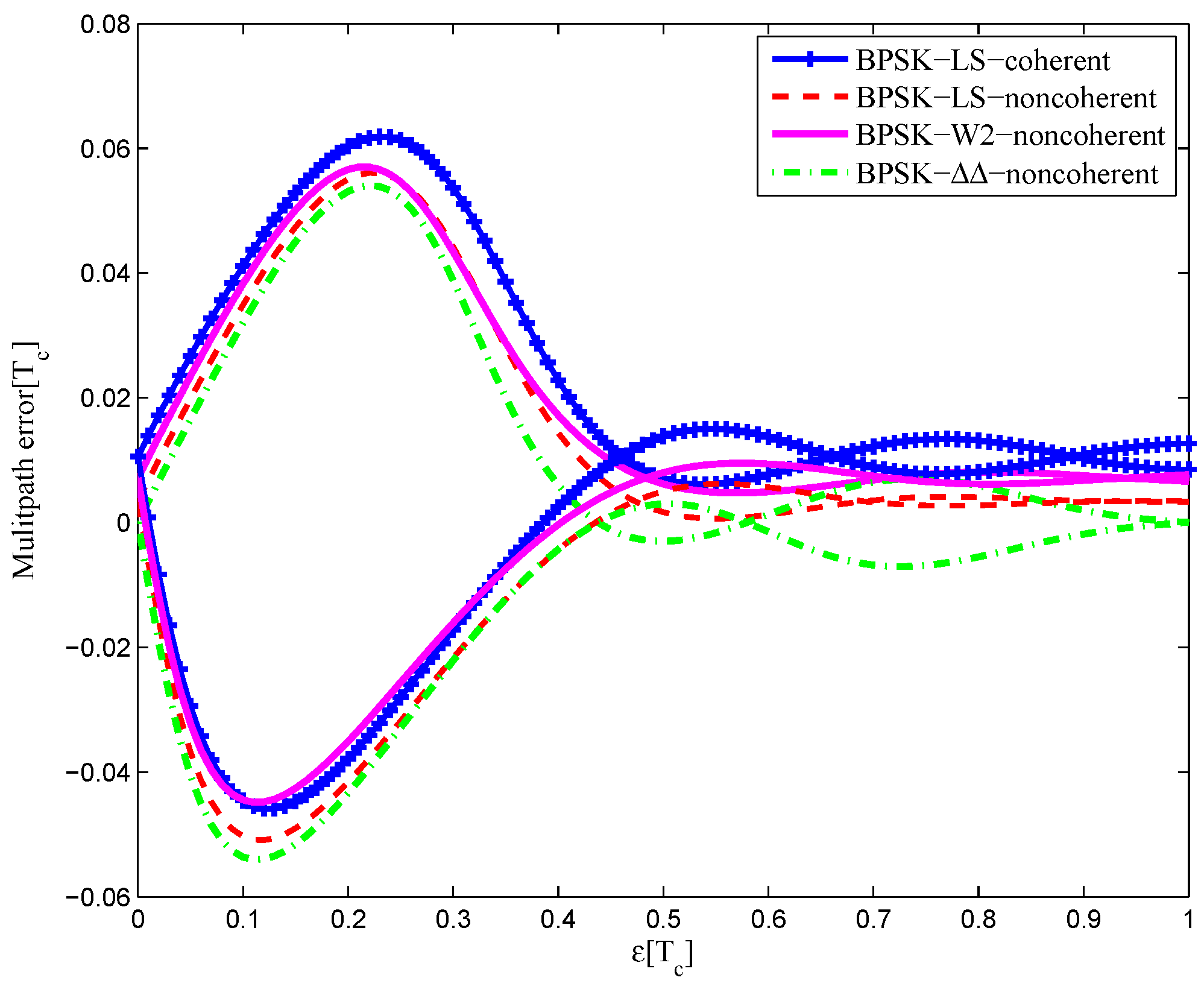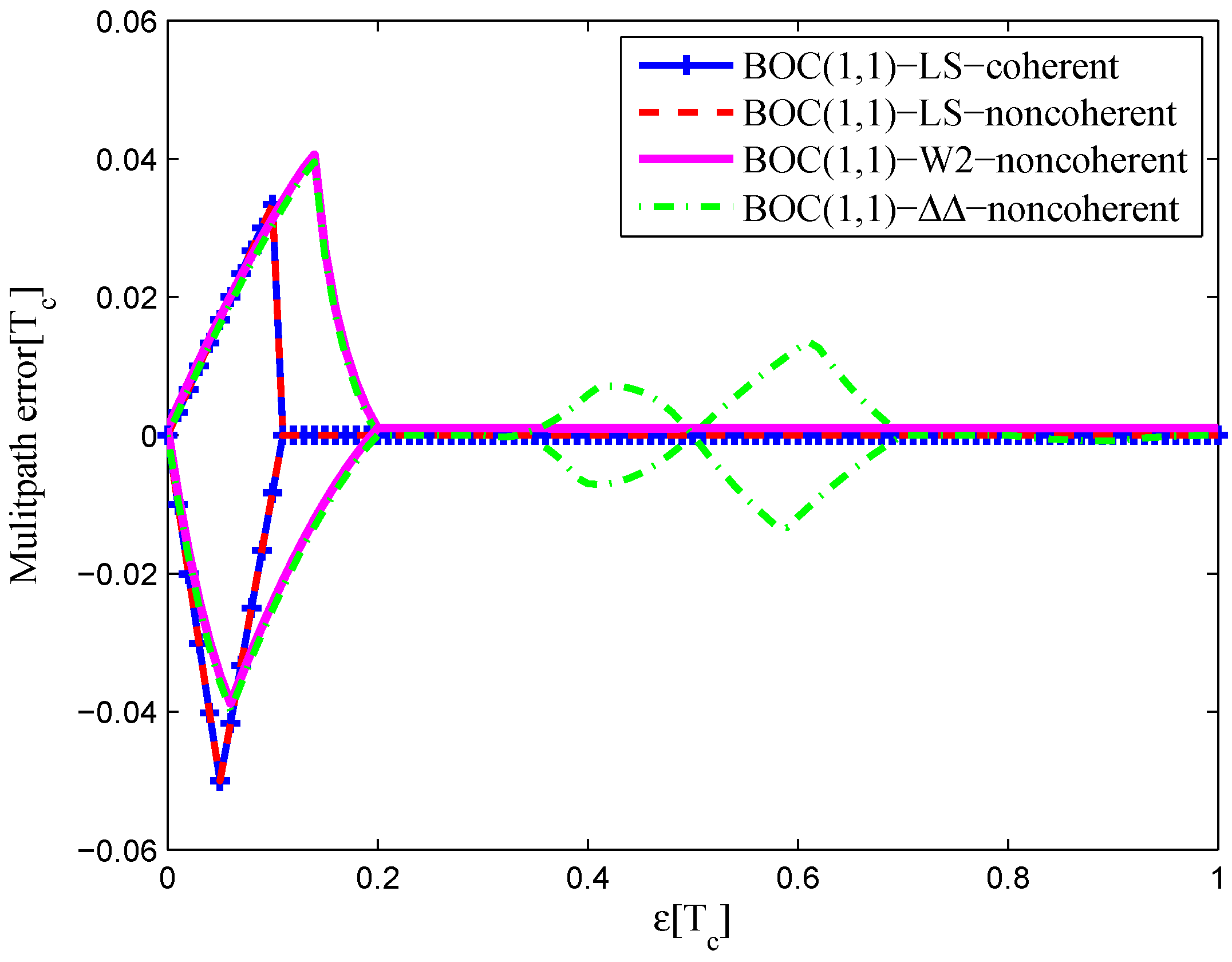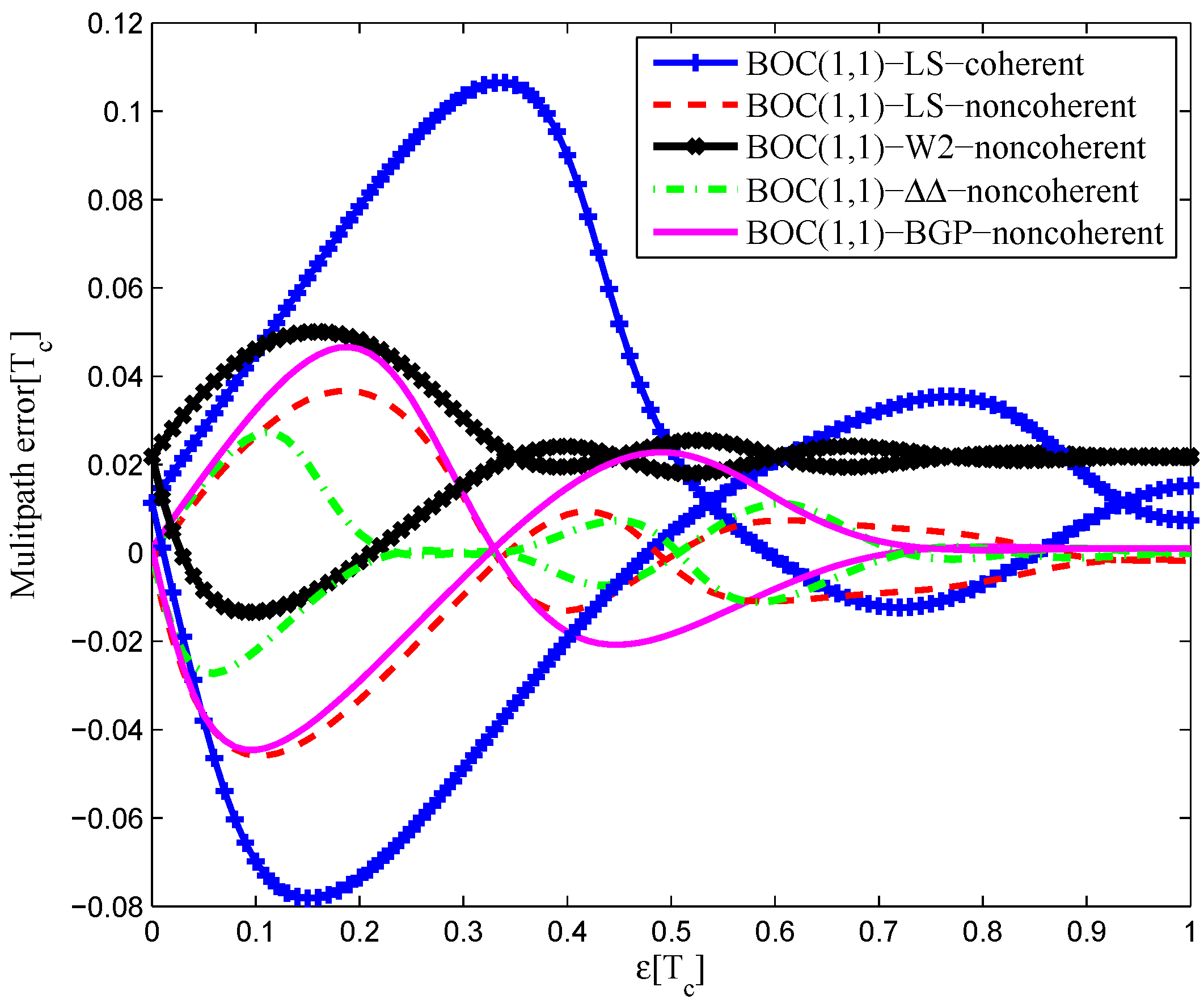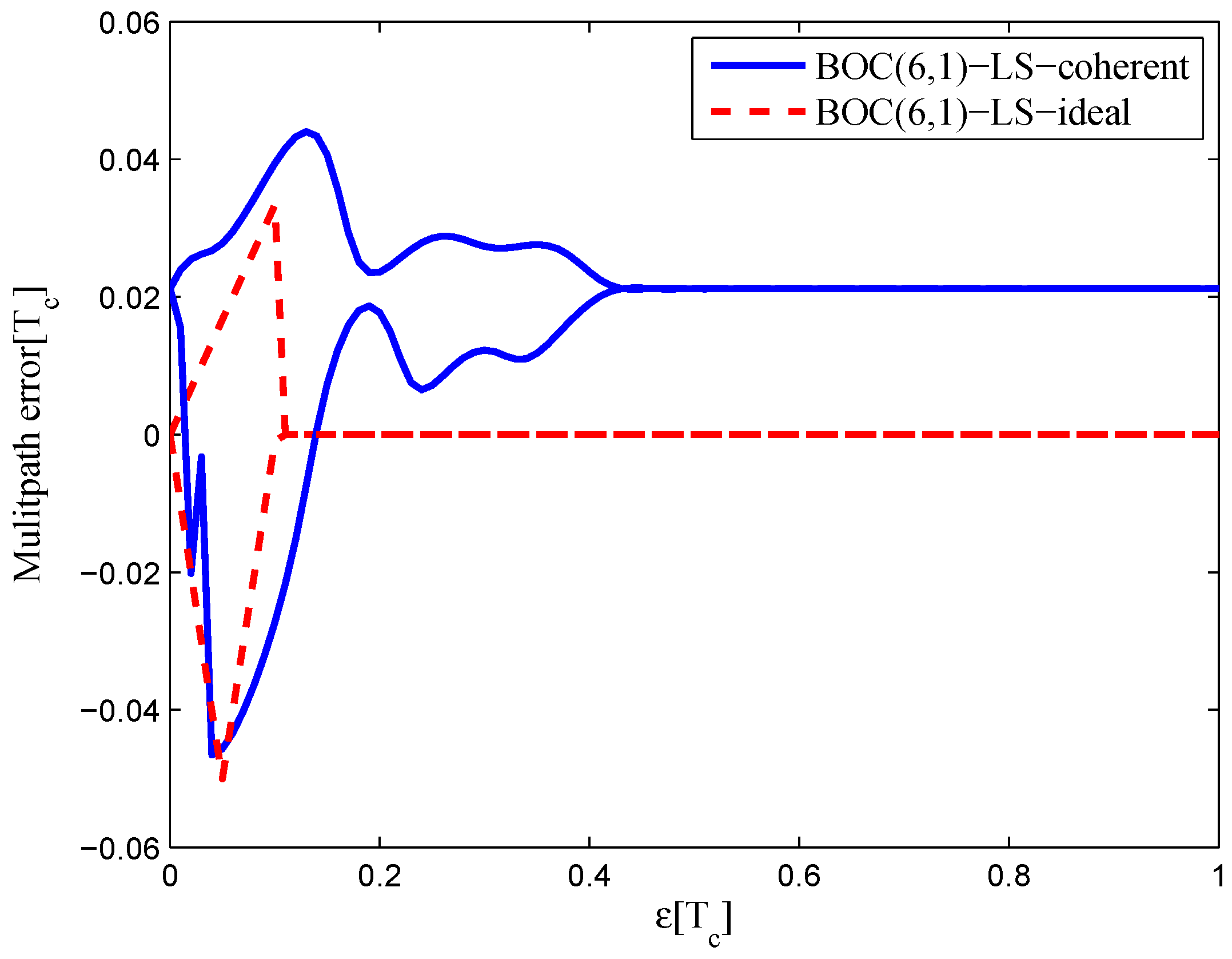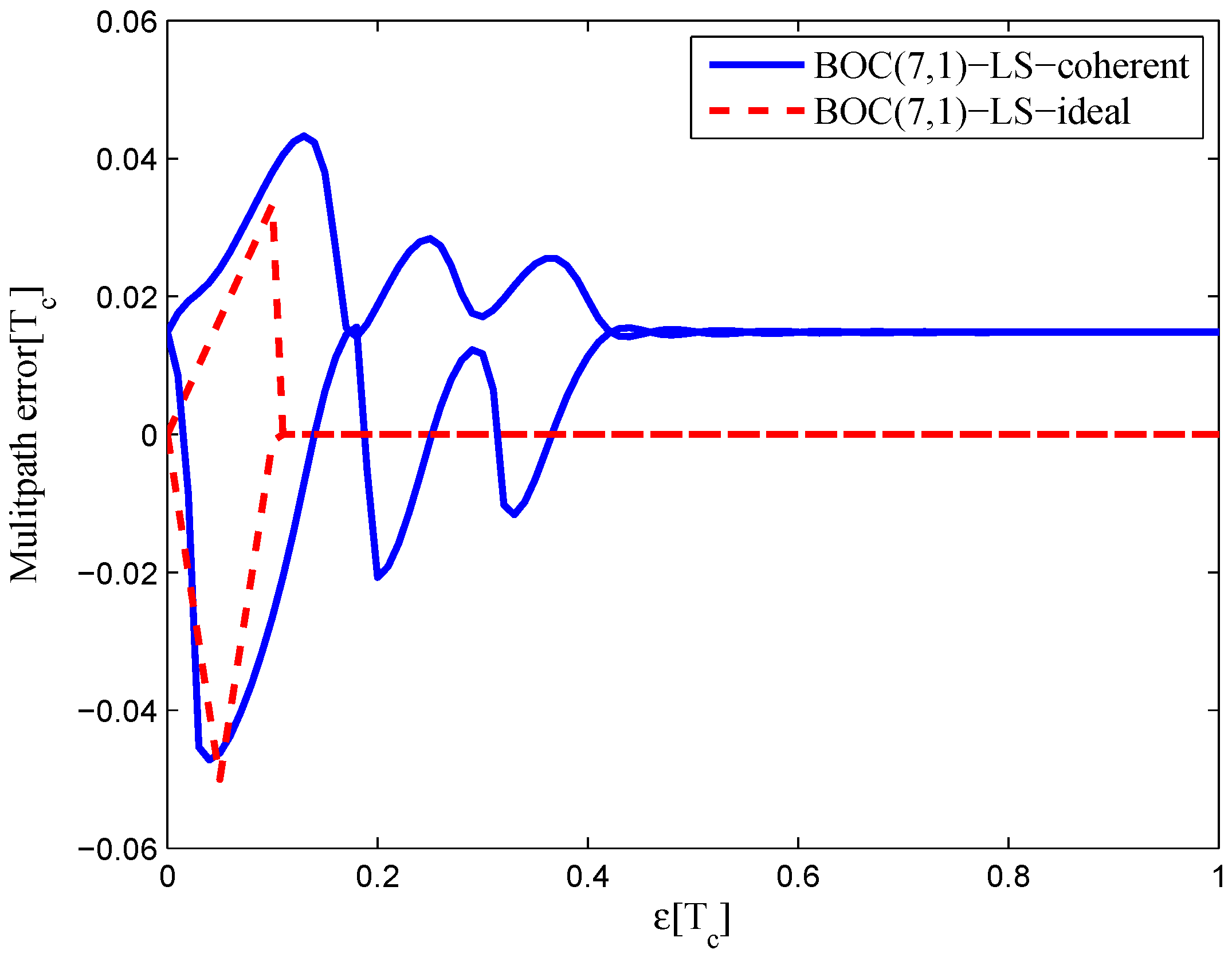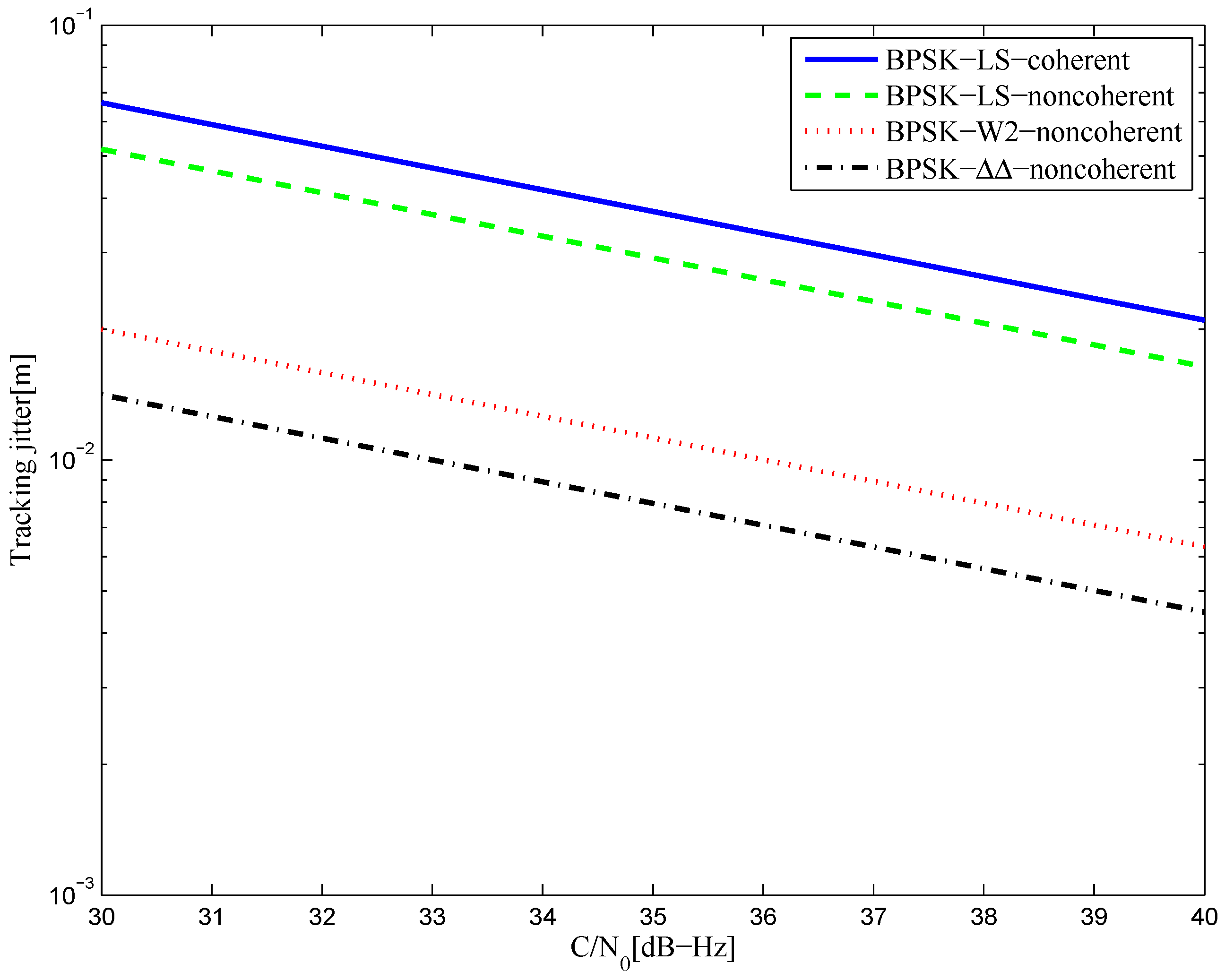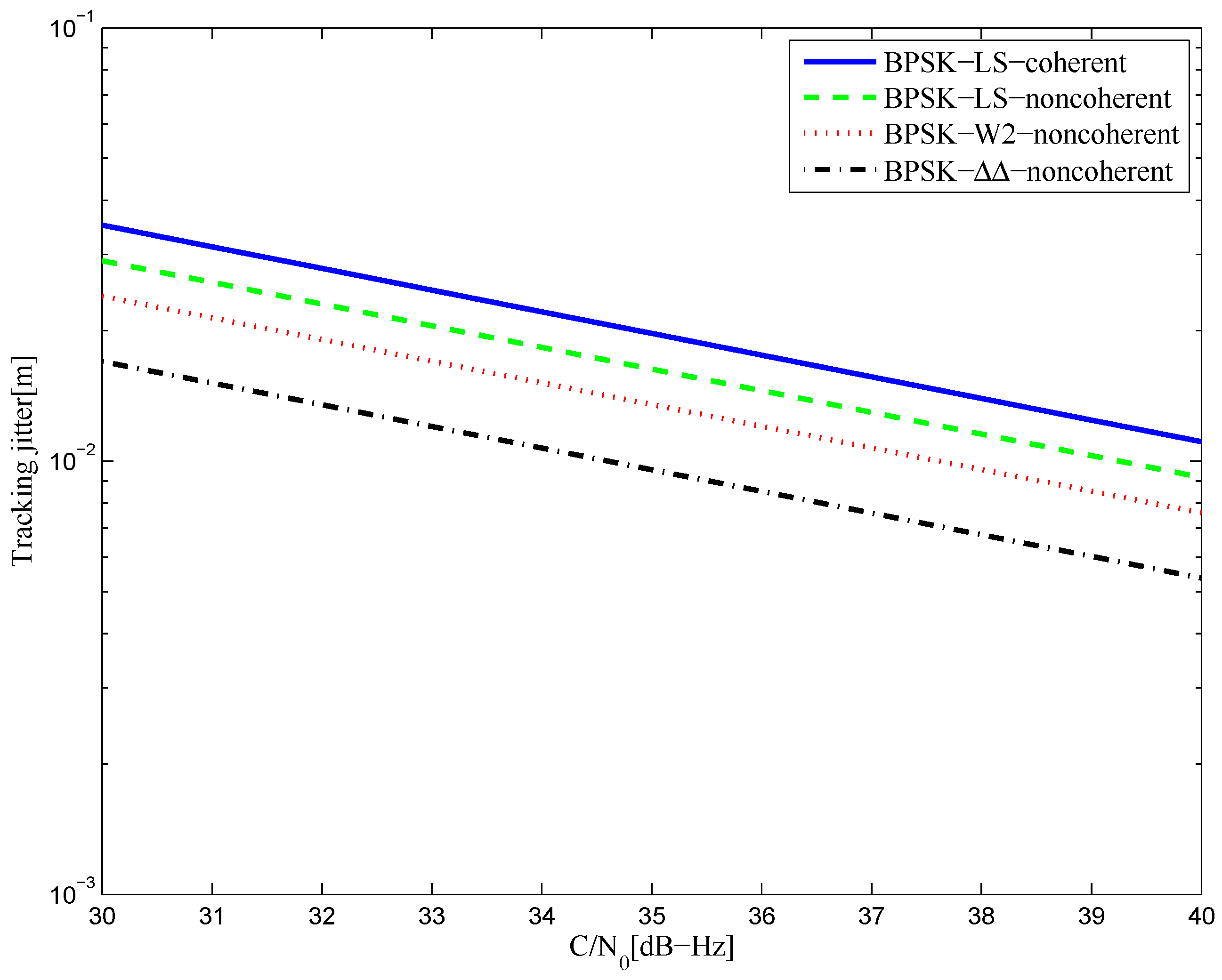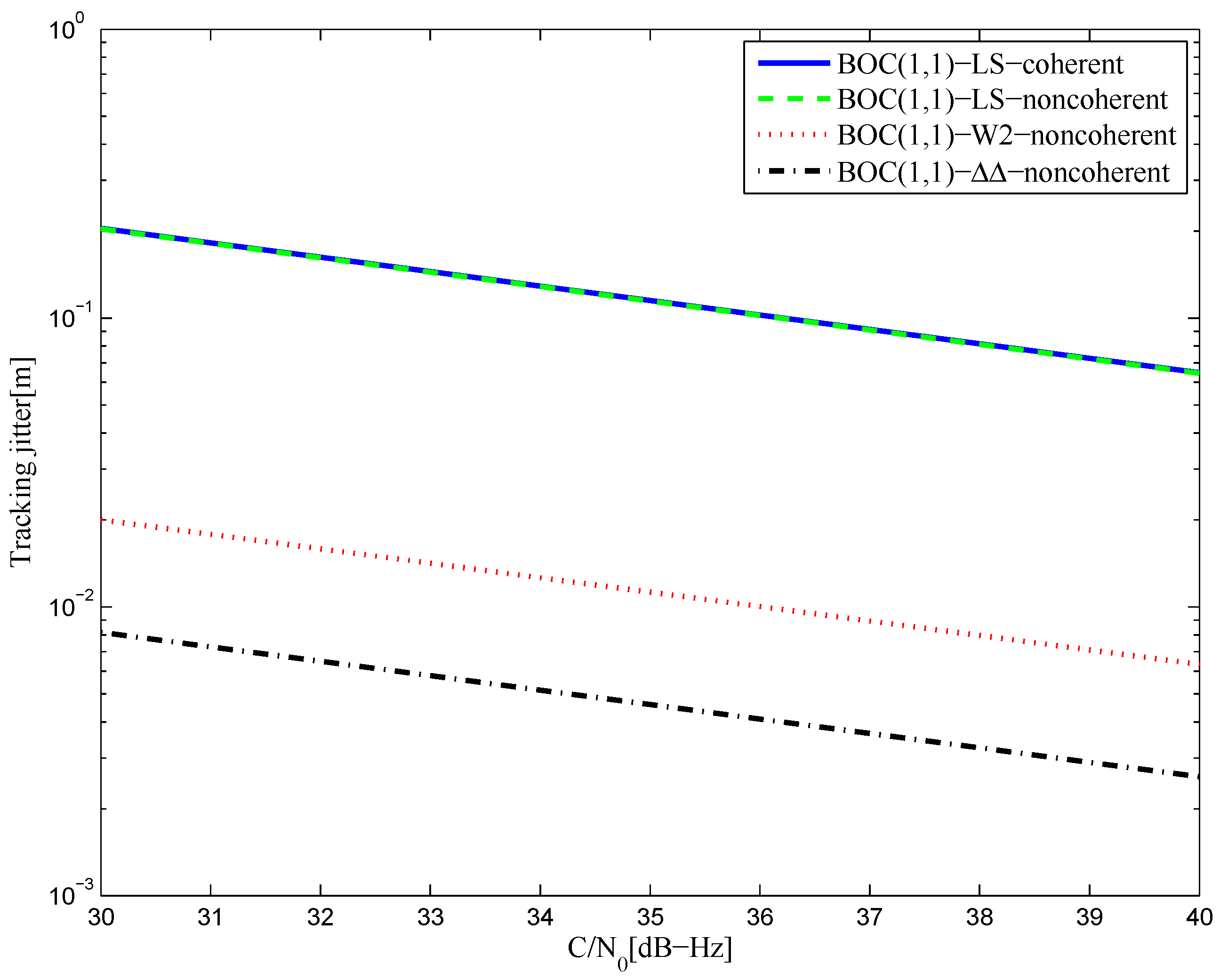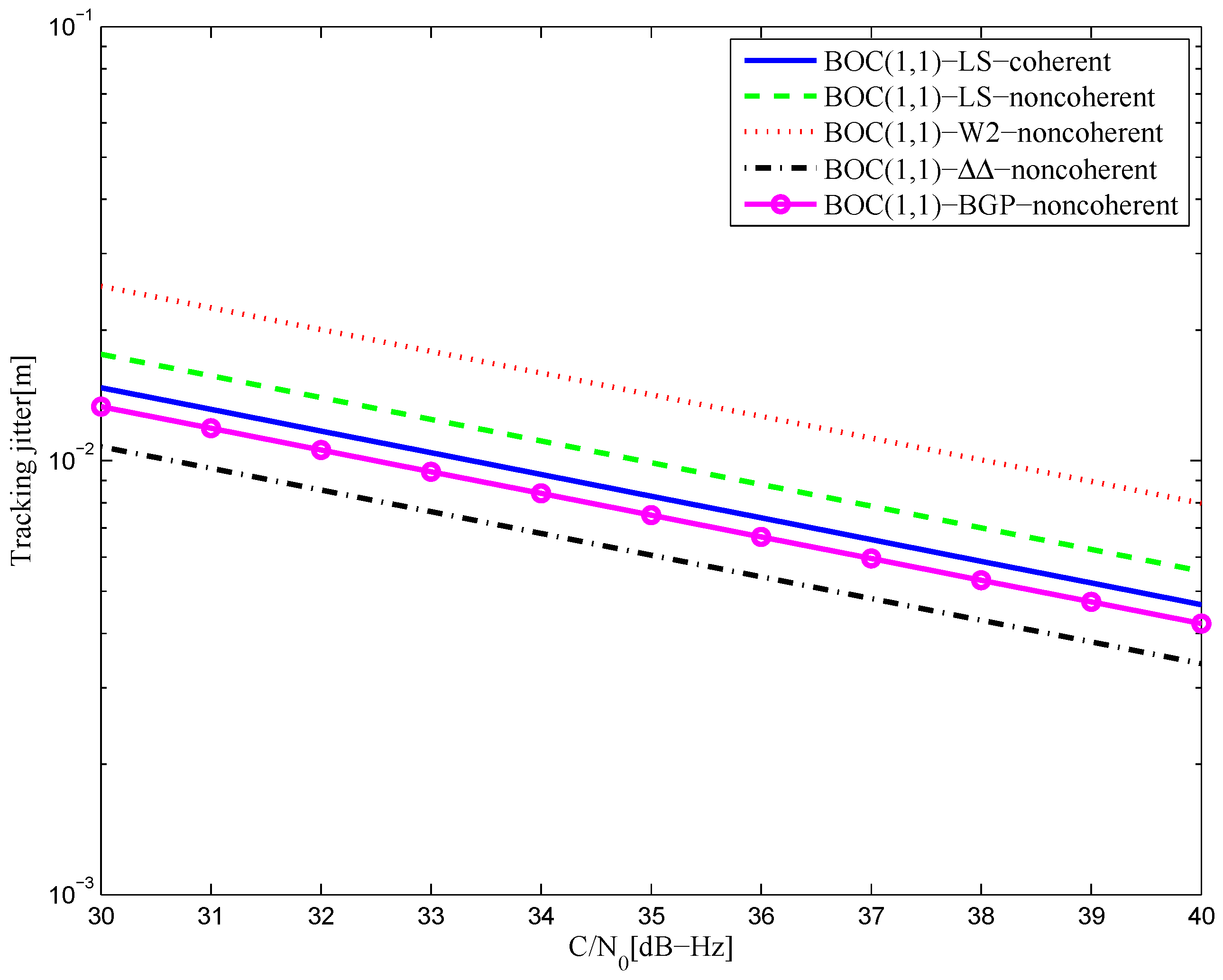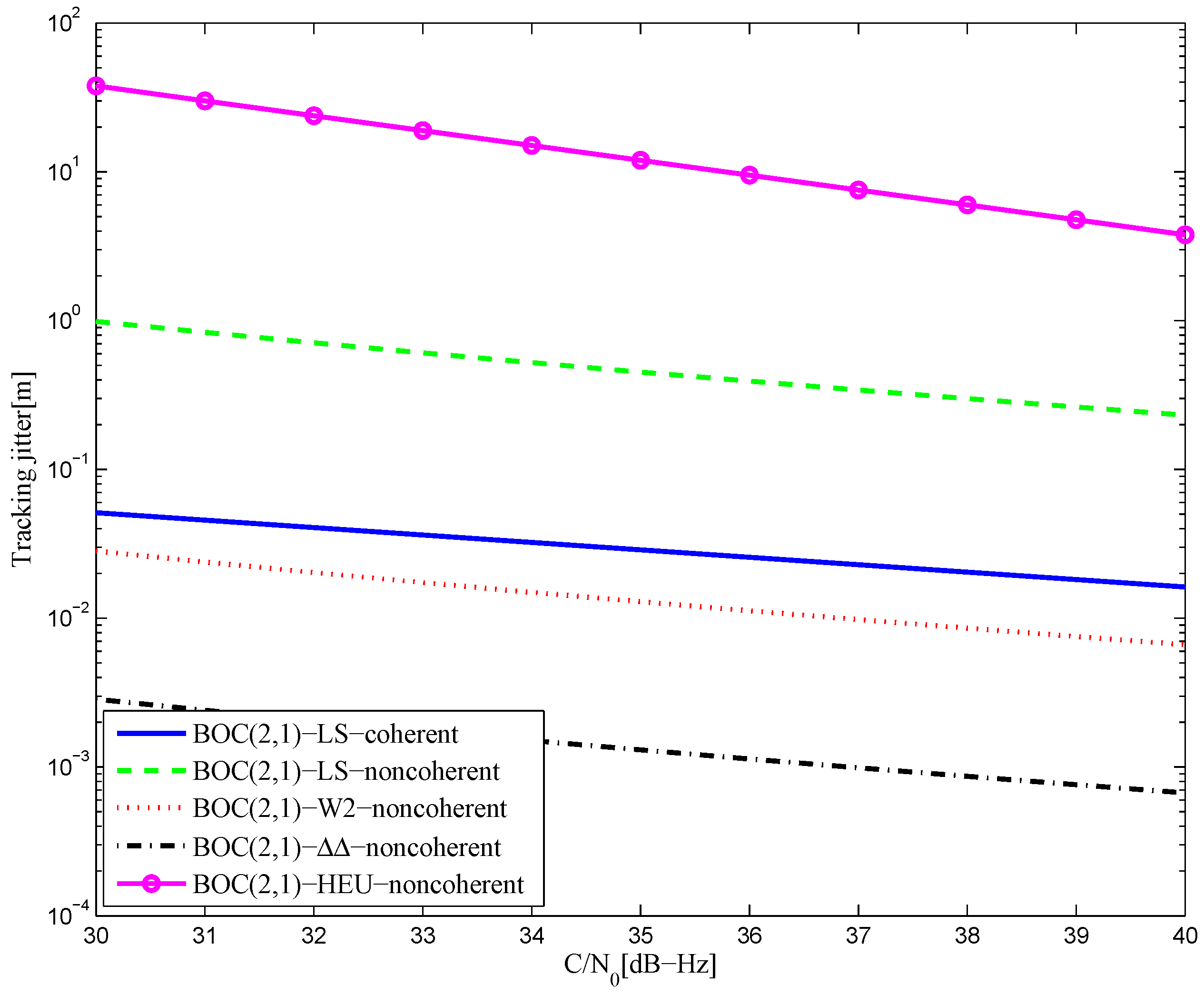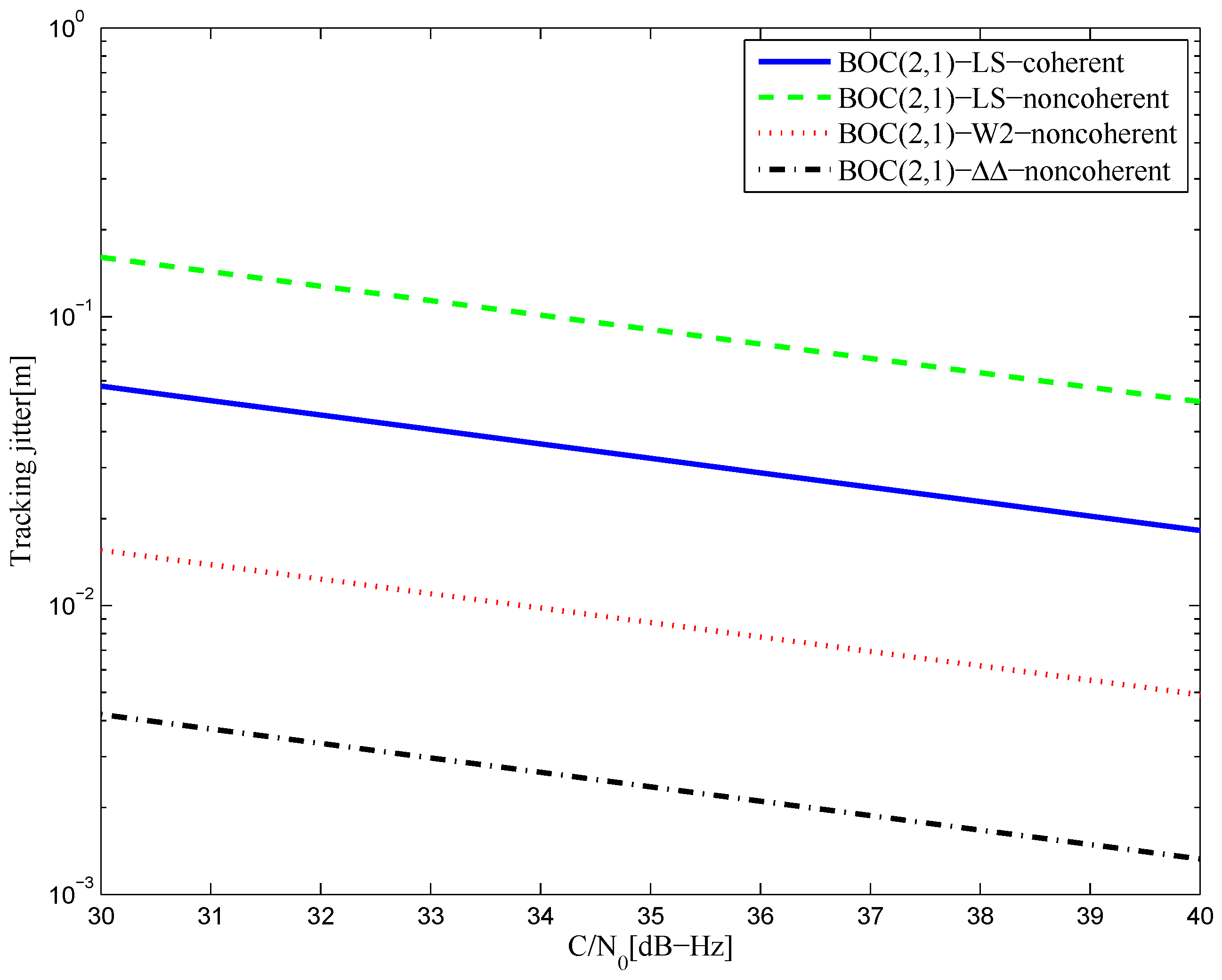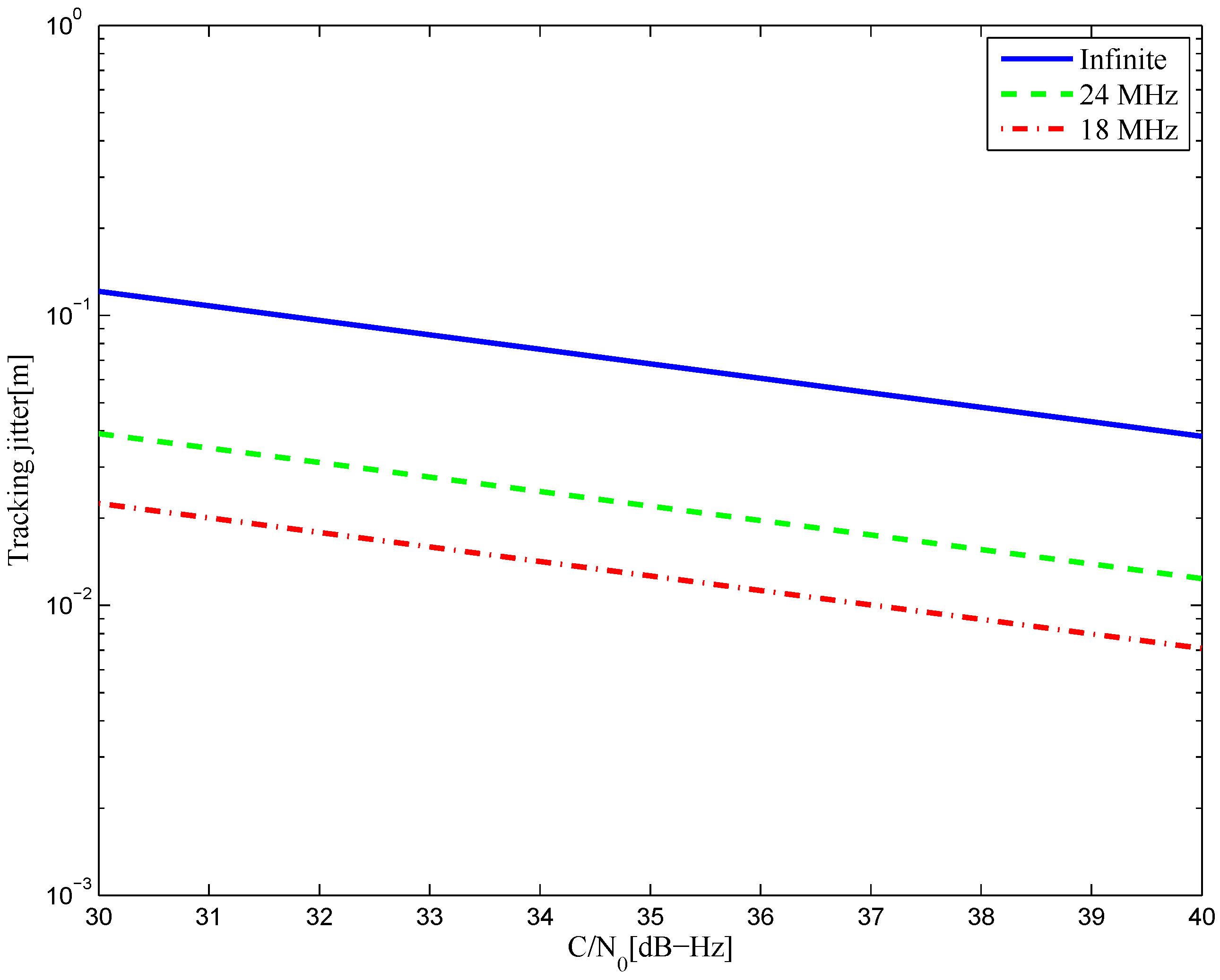Figure 1.
Diagram of the BOC signal and the BPSK signal time series.
Figure 1.
Diagram of the BOC signal and the BPSK signal time series.
Figure 2.
Simulation results of the false lock problem when the CCRW W2 discriminator is applied in a noisy environment (input = 35 dBHz, injecting a short period of strong interference at a time interval of 1 s, having 0.25 chips of gate width).
Figure 2.
Simulation results of the false lock problem when the CCRW W2 discriminator is applied in a noisy environment (input = 35 dBHz, injecting a short period of strong interference at a time interval of 1 s, having 0.25 chips of gate width).
Figure 3.
S-curves of non-coherent W2 discriminators (having 0.25 chips of gate width).
Figure 3.
S-curves of non-coherent W2 discriminators (having 0.25 chips of gate width).
Figure 4.
Waveforms of different code correlation reference waveforms.
Figure 4.
Waveforms of different code correlation reference waveforms.
Figure 5.
Schematic diagram of the code correlation reference waveform.
Figure 5.
Schematic diagram of the code correlation reference waveform.
Figure 6.
Singular value of the BPSK(1) signal with different bandwidths.
Figure 6.
Singular value of the BPSK(1) signal with different bandwidths.
Figure 7.
Ill-conditioned S-curves of the BPSK(1) signal with an 8.184-MHz bandwidth.
Figure 7.
Ill-conditioned S-curves of the BPSK(1) signal with an 8.184-MHz bandwidth.
Figure 8.
Comparison of the S-curves of the BPSK(1) signal in different precisions with an 8.184-MHz bandwidth.
Figure 8.
Comparison of the S-curves of the BPSK(1) signal in different precisions with an 8.184-MHz bandwidth.
Figure 9.
Code correlation reference waveform diagram for the BPSK(1) signal coherent discriminator (infinite bandwidth).
Figure 9.
Code correlation reference waveform diagram for the BPSK(1) signal coherent discriminator (infinite bandwidth).
Figure 10.
Code correlation reference waveform diagram for the BPSK(1) signal non-coherent discriminator (infinite bandwidth).
Figure 10.
Code correlation reference waveform diagram for the BPSK(1) signal non-coherent discriminator (infinite bandwidth).
Figure 11.
Fitted S-curves for the BPSK(1) signal (infinite bandwidth).
Figure 11.
Fitted S-curves for the BPSK(1) signal (infinite bandwidth).
Figure 12.
Code correlation reference waveform diagram for the BPSK(1) signal coherent discriminator (4.092-MHz bandwidth).
Figure 12.
Code correlation reference waveform diagram for the BPSK(1) signal coherent discriminator (4.092-MHz bandwidth).
Figure 13.
Code correlation reference waveform diagram for the BPSK(1) signal non-coherent discriminator (4.092-MHz bandwidth).
Figure 13.
Code correlation reference waveform diagram for the BPSK(1) signal non-coherent discriminator (4.092-MHz bandwidth).
Figure 14.
Fitted S-curves for the BPSK(1) signal (4.092-MHz bandwidth).
Figure 14.
Fitted S-curves for the BPSK(1) signal (4.092-MHz bandwidth).
Figure 15.
Code correlation reference waveform diagram for the BOC(1,1) signal coherent discriminator (infinite bandwidth).
Figure 15.
Code correlation reference waveform diagram for the BOC(1,1) signal coherent discriminator (infinite bandwidth).
Figure 16.
Code correlation reference waveform diagram for the BOC(1,1) signal non-coherent discriminator (infinite bandwidth).
Figure 16.
Code correlation reference waveform diagram for the BOC(1,1) signal non-coherent discriminator (infinite bandwidth).
Figure 17.
Fitted S-curves for the BOC(1,1) signal (infinite bandwidth).
Figure 17.
Fitted S-curves for the BOC(1,1) signal (infinite bandwidth).
Figure 18.
Code correlation reference waveform diagram for the BOC(1,1) signal coherent discriminator (6.138-MHz bandwidth).
Figure 18.
Code correlation reference waveform diagram for the BOC(1,1) signal coherent discriminator (6.138-MHz bandwidth).
Figure 19.
Code correlation reference waveform diagram for the BOC(1,1) signal non-coherent discriminator (6.138-MHz bandwidth).
Figure 19.
Code correlation reference waveform diagram for the BOC(1,1) signal non-coherent discriminator (6.138-MHz bandwidth).
Figure 20.
Fitted S-curves for the BOC(1,1) signal (6.138-MHz bandwidth).
Figure 20.
Fitted S-curves for the BOC(1,1) signal (6.138-MHz bandwidth).
Figure 21.
Simulation results of the false lock problem when the LS non-coherent discriminator is applied in a noisy environment (input = 35 dBHz, injecting a short period of strong interference at a time interval of 1 s, double-sided bandwidth = 6.138 MHz).
Figure 21.
Simulation results of the false lock problem when the LS non-coherent discriminator is applied in a noisy environment (input = 35 dBHz, injecting a short period of strong interference at a time interval of 1 s, double-sided bandwidth = 6.138 MHz).
Figure 22.
Code correlation reference waveform diagram for the BOC(2,1) signal coherent discriminator (infinite bandwidth).
Figure 22.
Code correlation reference waveform diagram for the BOC(2,1) signal coherent discriminator (infinite bandwidth).
Figure 23.
Code correlation reference waveform diagram for the BOC(2,1) signal non-coherent discriminator (infinite bandwidth).
Figure 23.
Code correlation reference waveform diagram for the BOC(2,1) signal non-coherent discriminator (infinite bandwidth).
Figure 24.
Fitted S-curves for the BOC(2,1) signal (infinite bandwidth).
Figure 24.
Fitted S-curves for the BOC(2,1) signal (infinite bandwidth).
Figure 25.
Fitted S-curves for the BOC(2,1) signal (8.184-MHz bandwidth).
Figure 25.
Fitted S-curves for the BOC(2,1) signal (8.184-MHz bandwidth).
Figure 26.
Code correlation reference waveform diagram for the BOC(2,1) signal coherent discriminator (8.184-MHz bandwidth).
Figure 26.
Code correlation reference waveform diagram for the BOC(2,1) signal coherent discriminator (8.184-MHz bandwidth).
Figure 27.
Code correlation reference waveform diagram for the BOC(2,1) signal non-coherent discriminator (8.184-MHz bandwidth).
Figure 27.
Code correlation reference waveform diagram for the BOC(2,1) signal non-coherent discriminator (8.184-MHz bandwidth).
Figure 28.
Code correlation reference waveform diagram for the BOC(6,1) signal coherent discriminator (24.552-MHz bandwidth).
Figure 28.
Code correlation reference waveform diagram for the BOC(6,1) signal coherent discriminator (24.552-MHz bandwidth).
Figure 29.
Fitted S-curves for the BOC(6,1) signal (24.552-MHz bandwidth).
Figure 29.
Fitted S-curves for the BOC(6,1) signal (24.552-MHz bandwidth).
Figure 30.
Code correlation reference waveform diagram for the BOC(7,1) signal coherent discriminator (20.46-MHz bandwidth).
Figure 30.
Code correlation reference waveform diagram for the BOC(7,1) signal coherent discriminator (20.46-MHz bandwidth).
Figure 31.
Fitted S-curves for the BOC(7,1) signal (20.46-MHz bandwidth).
Figure 31.
Fitted S-curves for the BOC(7,1) signal (20.46-MHz bandwidth).
Figure 32.
Multipath error envelopes for S-curves of the BPSK(1) signal (infinite bandwidth).
Figure 32.
Multipath error envelopes for S-curves of the BPSK(1) signal (infinite bandwidth).
Figure 33.
Multipath error envelopes for the S-curves of the BPSK(1) signal (4.092-MHz bandwidth).
Figure 33.
Multipath error envelopes for the S-curves of the BPSK(1) signal (4.092-MHz bandwidth).
Figure 34.
Multipath error envelopes for the S-curves of the BOC(1,1) signal (infinite bandwidth).
Figure 34.
Multipath error envelopes for the S-curves of the BOC(1,1) signal (infinite bandwidth).
Figure 35.
Multipath error envelopes for the S-curves of the BOC(1,1) signal (6.138-MHz bandwidth).
Figure 35.
Multipath error envelopes for the S-curves of the BOC(1,1) signal (6.138-MHz bandwidth).
Figure 36.
Multipath error envelopes for the S-curves of the BOC(2,1) signal (infinite bandwidth).
Figure 36.
Multipath error envelopes for the S-curves of the BOC(2,1) signal (infinite bandwidth).
Figure 37.
Multipath error envelopes for the S-curves of the BOC(2,1) signal (8.184-MHz bandwidth).
Figure 37.
Multipath error envelopes for the S-curves of the BOC(2,1) signal (8.184-MHz bandwidth).
Figure 38.
Multipath error envelopes for the S-curves of the BOC(6,1) signal (24.552-MHz bandwidth).
Figure 38.
Multipath error envelopes for the S-curves of the BOC(6,1) signal (24.552-MHz bandwidth).
Figure 39.
Multipath error envelopes for the S-curves of the BOC(7,1) signal (20.46-MHz bandwidth).
Figure 39.
Multipath error envelopes for the S-curves of the BOC(7,1) signal (20.46-MHz bandwidth).
Figure 40.
The tracking jitters for the S-curves of the BPSK(1) signal (infinite bandwidth).
Figure 40.
The tracking jitters for the S-curves of the BPSK(1) signal (infinite bandwidth).
Figure 41.
The tracking jitters for the S-curves of the BPSK(1) signal (4.092-MHz bandwidth).
Figure 41.
The tracking jitters for the S-curves of the BPSK(1) signal (4.092-MHz bandwidth).
Figure 42.
The tracking jitters for the S-curves of the BOC(1,1) signal (infinite bandwidth).
Figure 42.
The tracking jitters for the S-curves of the BOC(1,1) signal (infinite bandwidth).
Figure 43.
The tracking jitters for the S-curves of the BOC(1,1) signal (6.138-MHz bandwidth).
Figure 43.
The tracking jitters for the S-curves of the BOC(1,1) signal (6.138-MHz bandwidth).
Figure 44.
The tracking jitters for the S-curves of the BOC(2,1) signal (infinite bandwidth).
Figure 44.
The tracking jitters for the S-curves of the BOC(2,1) signal (infinite bandwidth).
Figure 45.
The tracking jitters for the S-curves of the BOC(2,1) signal (8.184-MHz bandwidth).
Figure 45.
The tracking jitters for the S-curves of the BOC(2,1) signal (8.184-MHz bandwidth).
Figure 46.
The tracking jitters for the S-curves of the BOC(6,1) signal.
Figure 46.
The tracking jitters for the S-curves of the BOC(6,1) signal.
Figure 47.
The tracking jitters for the S-curves of the BOC(7,1) signal.
Figure 47.
The tracking jitters for the S-curves of the BOC(7,1) signal.
Table 1.
Simulation parameters for the BPSK(1) signal.
Table 1.
Simulation parameters for the BPSK(1) signal.
| Scenario | Infinite Bandwidth | 16.368 MHz | 8.184 MHz | 4.092 MHz |
|---|
| Fitting range (±chips) | 1 | 1 | 1 | 1 |
| Linear region (±chips) | 0.1 | 0.1 | 0.1 | 0.2 |
| Offset (chips) | 0 | 0.01 | 0.01 | 0.01 |
| Waveform range (chips) | −0.11∼0.11 | −0.15∼0.15 | −0.2∼0.2 | −0.4∼0.4 |
| Gate width (chips) | 0.01 | 0.05 | 0.1 | 0.2 |
Table 2.
Simulation parameters for the BOC(1,1) signal.
Table 2.
Simulation parameters for the BOC(1,1) signal.
| Scenario | Infinite Bandwidth | 24.552 MHz | 12.276 MHz | 6.138 MHz |
|---|
| Fitting range (±chips) | 1 | 1 | 1 | 1 |
| Linear region (±chips) | 0.1 | 0.1 | 0.1 | 0.2 |
| Offset (chips) | 0 | 0.02 | 0.03 | 0.03 |
| Waveform range (chips) | −0.11∼0.11 | −0.15∼0.15 | −0.2∼0.2 | −0.4∼0.4 |
| Gate width (chips) | 0.01 | 0.05 | 0.1 | 0.2 |
Table 3.
Simulation parameters for the BOC(2,1) signal.
Table 3.
Simulation parameters for the BOC(2,1) signal.
| Scenario | Infinite Bandwidth | 16.368 MHz | 8.184 MHz |
|---|
| Fitting range (±chips) | 1 | 1 | 1 |
| Linear region (±chips) | 0.1 | 0.1 | 0.1 |
| Offset (chips) | 0 (coherent) | 0.02 (coherent) | 0.02 (coherent) |
| | 0.02 (noncoherent) | 0.03 (noncoherent) | 0.05 (noncoherent) |
| Waveform range (chips) | −0.5∼0.5 (coherent) | −0.8∼0.15 (coherent) | −0.8∼0.2 (coherent) |
| | −0.8∼0.2 (noncoherent) | −0.5∼0.5 (noncoherent) | −0.4∼0.4 (noncoherent) |
| Gate width (chips) | 0.01 | 0.05 (coherent), 0.02 (noncoherent) | 0.1 |
Table 4.
Simulation parameters for the BOC(6,1) signal.
Table 4.
Simulation parameters for the BOC(6,1) signal.
| Scenario | Infinite Bandwidth | 24.552 MHz | 18.414 MHz |
|---|
| Fitting range (±chips) | 1 | 1 | 1 |
| Linear region (±chips) | 0.1 | 0.1 | 0.1 |
| Offset (chips) | 0.01 | 0.03 | 0.03 |
| Waveform range (chips) | −0.5∼0.5 | −0.4∼0.4 | −0.4∼0.4 |
| Gate width (chips) | 0.01 | 0.05 | 0.05 |
Table 5.
Simulation parameters for the BOC(7,1) signal.
Table 5.
Simulation parameters for the BOC(7,1) signal.
| Scenario | Infinite Bandwidth | 20.46 MHz | 16.368 MHz |
|---|
| Fitting range (±chips) | 1 | 1 | 1 |
| Linear region (±chips) | 0.1 | 0.1 | 0.1 |
| Offset (chips) | 0.01 | 0.03 | 0.02 |
| Waveform range (chips) | −0.5∼0.5 | −0.6∼0.4 | −0.3∼0.3 |
| Gate width (chips) | 0.01 | 0.05 | 0.05 |
Table 6.
The multipath error envelope of the BPSK(1) signal.
Table 6.
The multipath error envelope of the BPSK(1) signal.
| Bandwidth | Coherent | Non-Coherent | W2 | |
|---|
| Infinite (chip) | 0.0044 | 0.0046 | 0.0093 | 0.0098 |
| 16.368 MHz (chip) | 0.0066 | 0.0098 | 0.0097 | 0.0103 |
| 8.184 MHz (chip) | 0.0067 | 0.0086 | 0.0082 | 0.0088 |
| 4.092 MHz (chip) | 0.0253 | 0.0287 | 0.0273 | 0.0302 |
Table 7.
The multipath error envelope of the BOC(1,1) signal.
Table 7.
The multipath error envelope of the BOC(1,1) signal.
| Bandwidth | Coherent | Non-Coherent | W2 | | BGP |
|---|
| Infinite (chip) | 0.0046 | 0.0046 | 0.0076 | 0.0119 | |
| 24.552 MHz (chip) | 0.0219 | 0.0140 | 0.0081 | 0.0129 | 0.0181 |
| 12.27 M6Hz (chip) | 0.0192 | 0.0086 | 0.0060 | 0.0095 | 0.0157 |
| 6.138 MHz (chip) | 0.0676 | 0.0246 | 0.0152 | 0.0115 | 0.0280 |
Table 8.
The multipath error envelope of the BOC(2,1) signal.
Table 8.
The multipath error envelope of the BOC(2,1) signal.
| Bandwidth | Coherent | Non-Coherent | W2 | | HEU |
|---|
| Infinite (chip) | 0.0057 | 0.0057 | 0.0039 | 0.0118 | 0.0045 |
| 16.368 MHz (chip) | 0.0143 | 0.0120 | 0.0047 | 0.0144 | 0.0039 |
| 8.184 MHz (chip) | 0.0105 | 0.0059 | 0.0034 | 0.0103 | 0.0056 |
Table 9.
The multipath error envelope of the BOC(6,1) and BOC(7,1) signals.
Table 9.
The multipath error envelope of the BOC(6,1) and BOC(7,1) signals.
| Bandwidth | BOC(6,1) | BOC(7,1) |
|---|
| Infinite (chip) | 0.0108 | 0.0087 |
| 24.552 MHz (chip) | 0.0119 | |
| 20.46 MHz (chip) | | 0.0093 |
| 18.414 MHz (chip) | 0.0119 | |
| 16.368 MHz (chip) | | 0.0093 |
